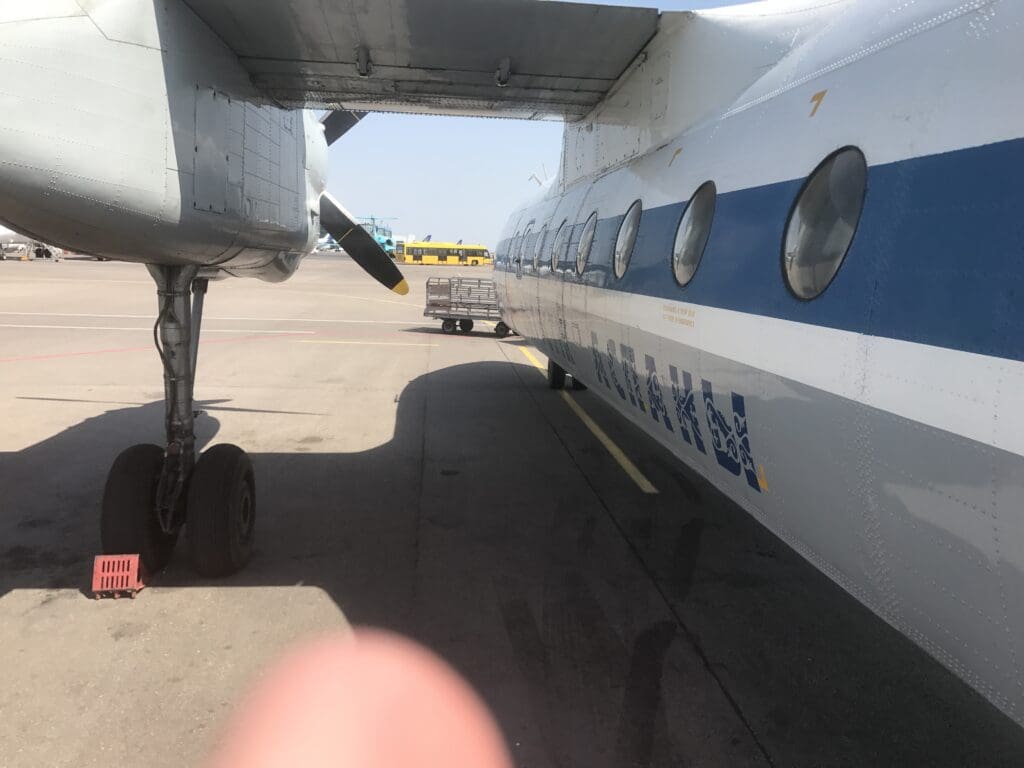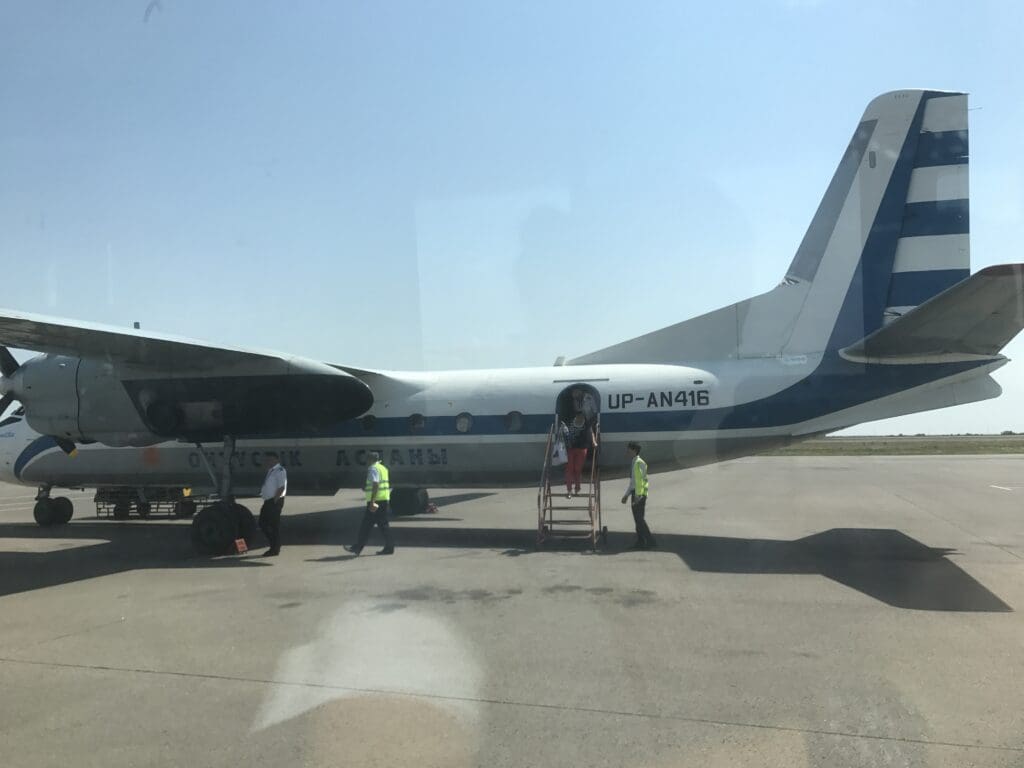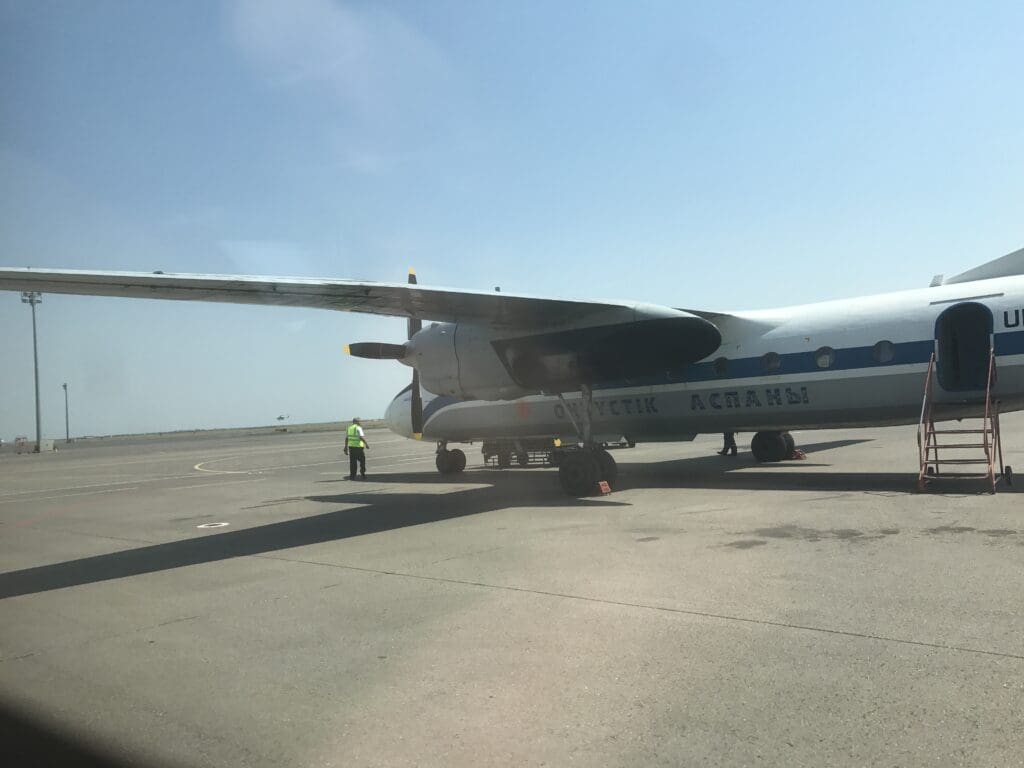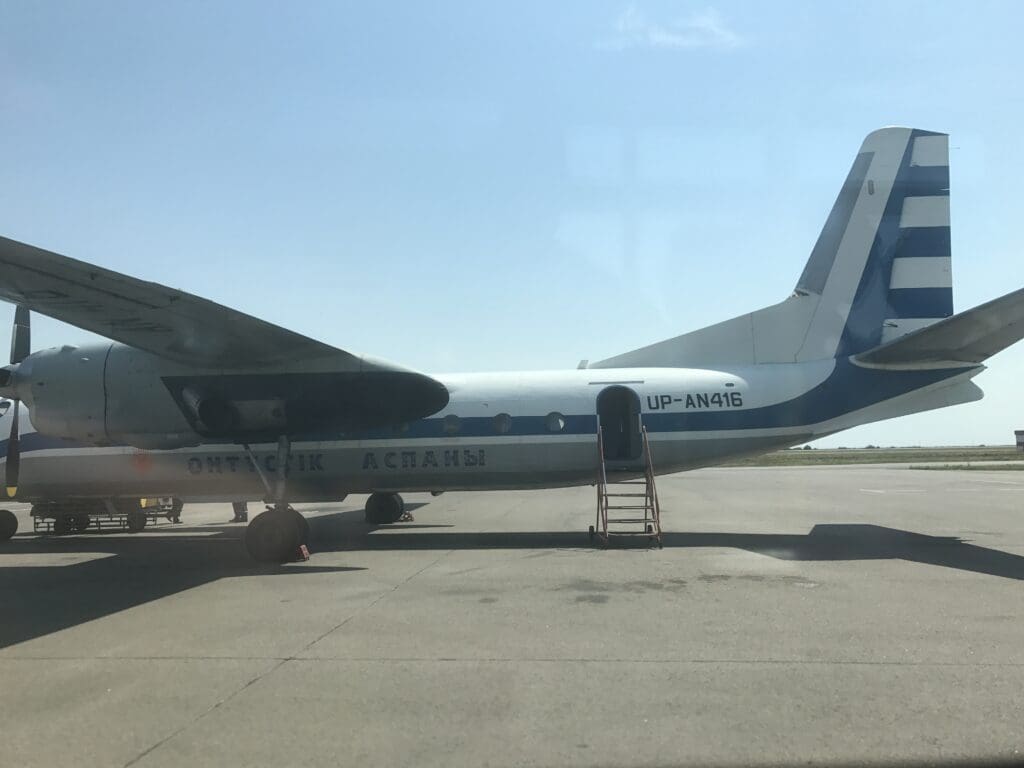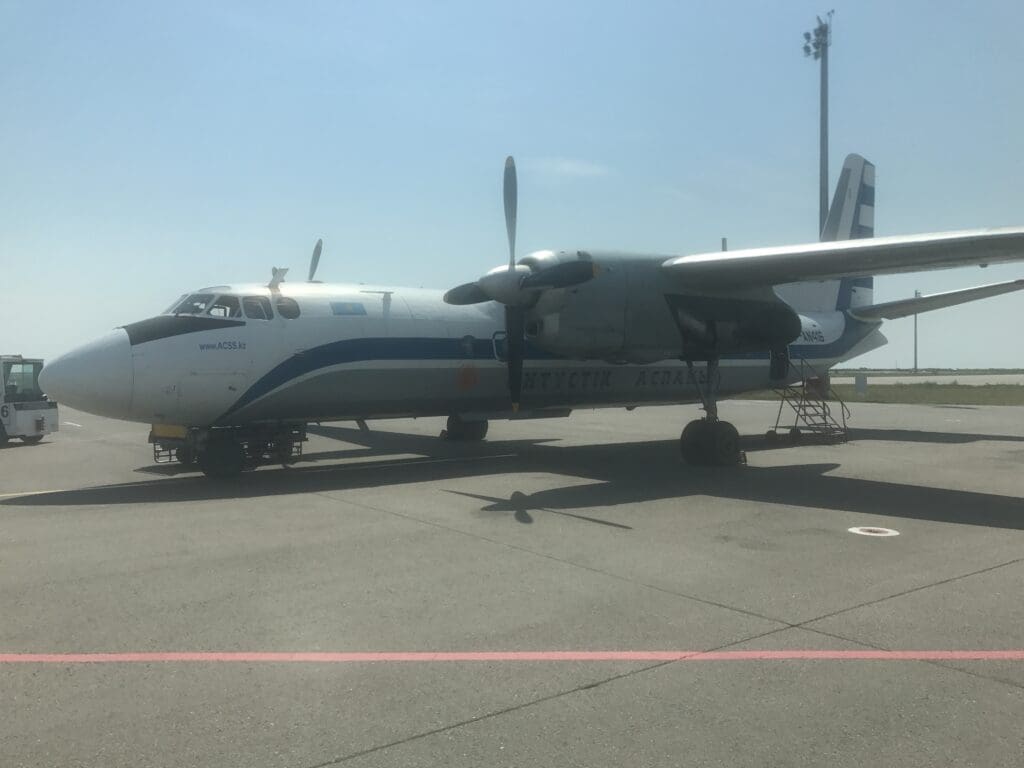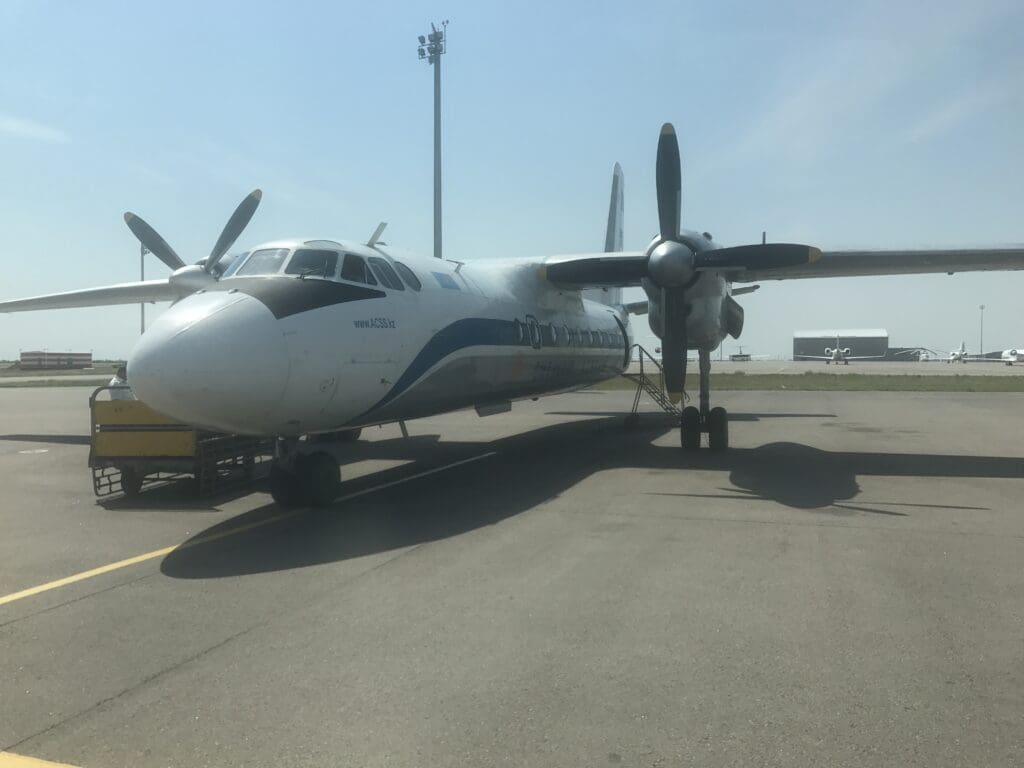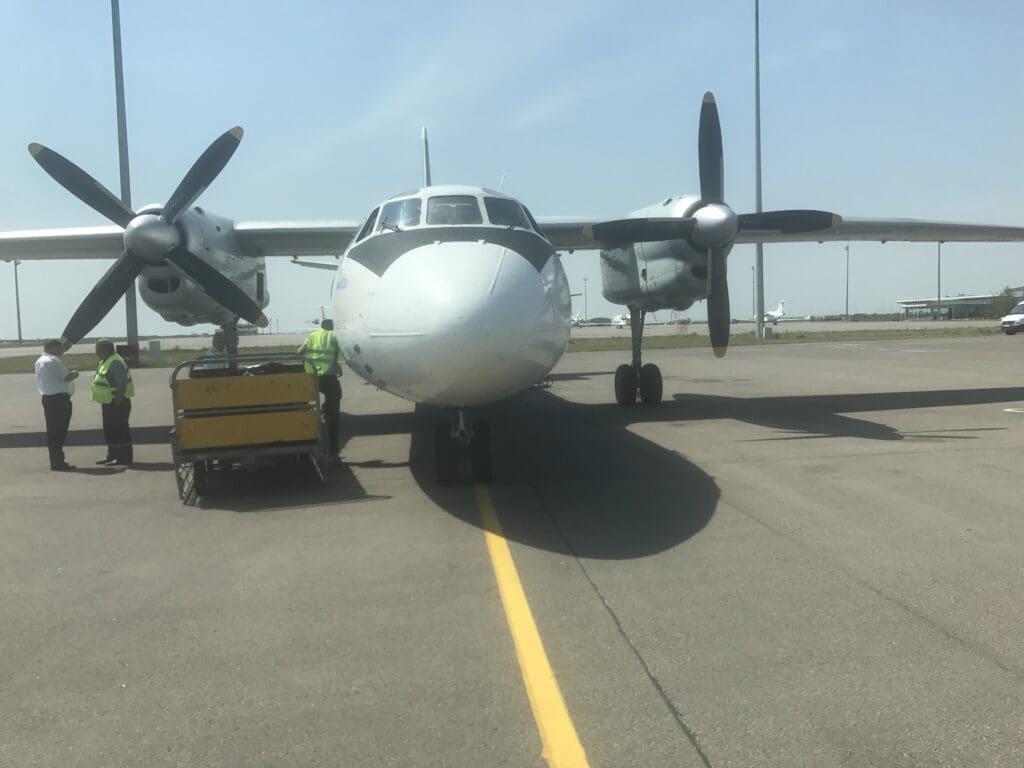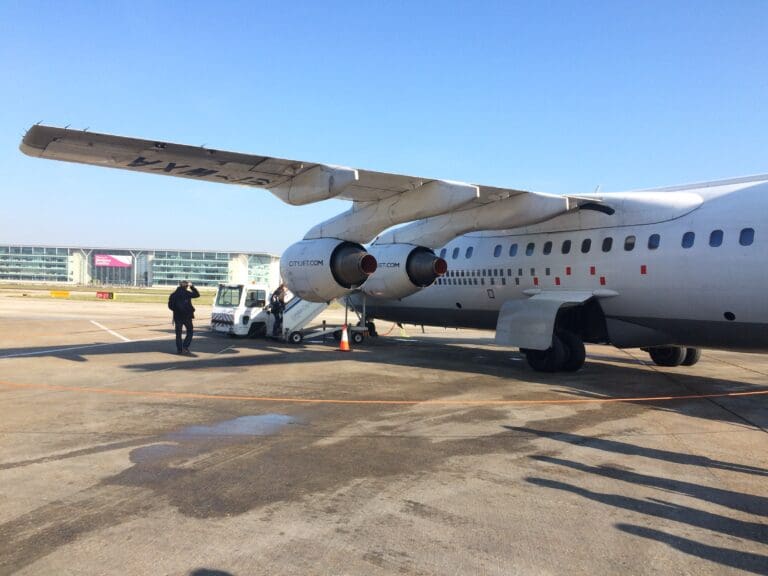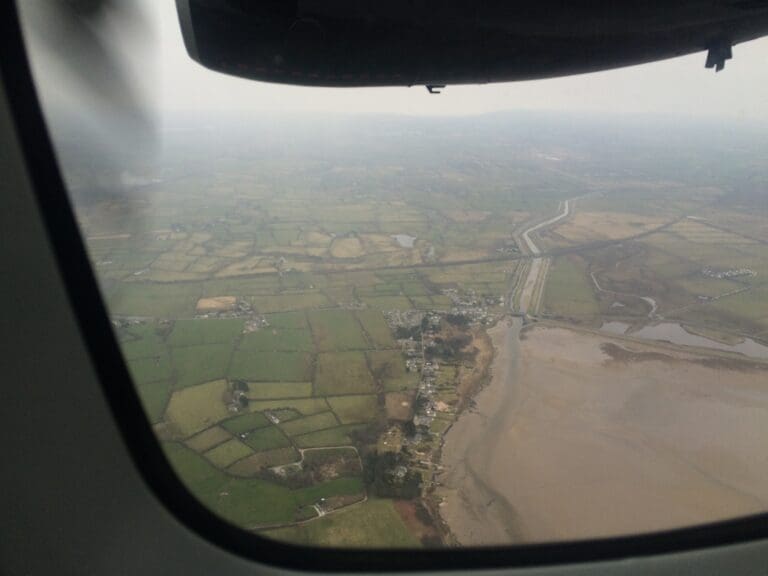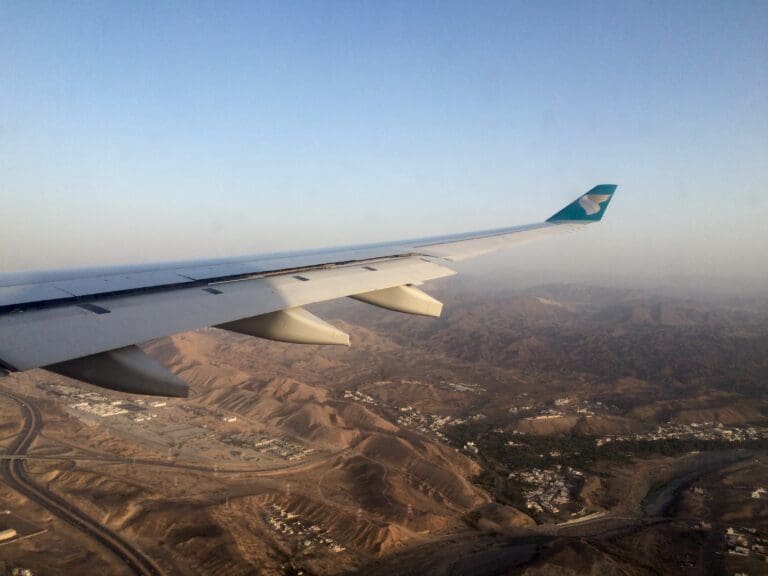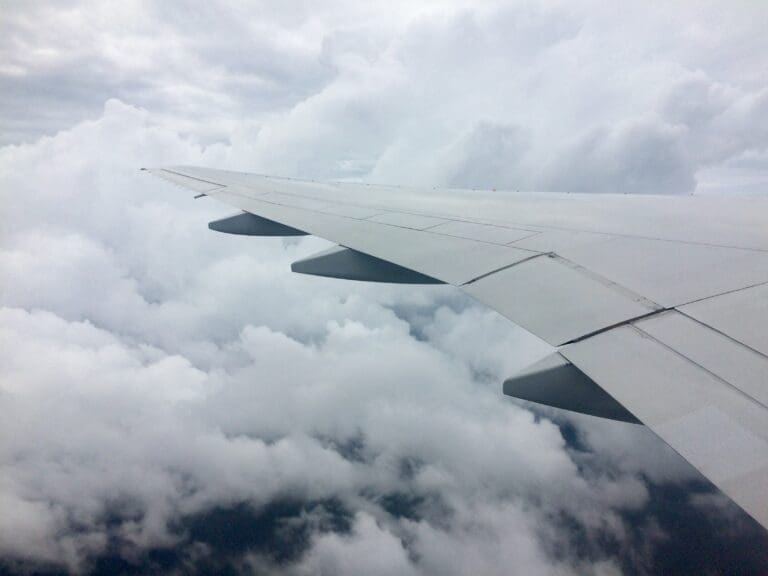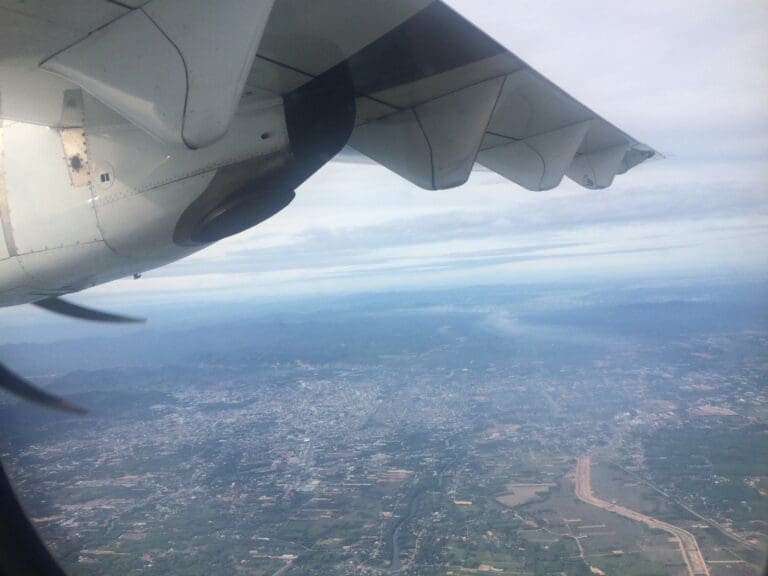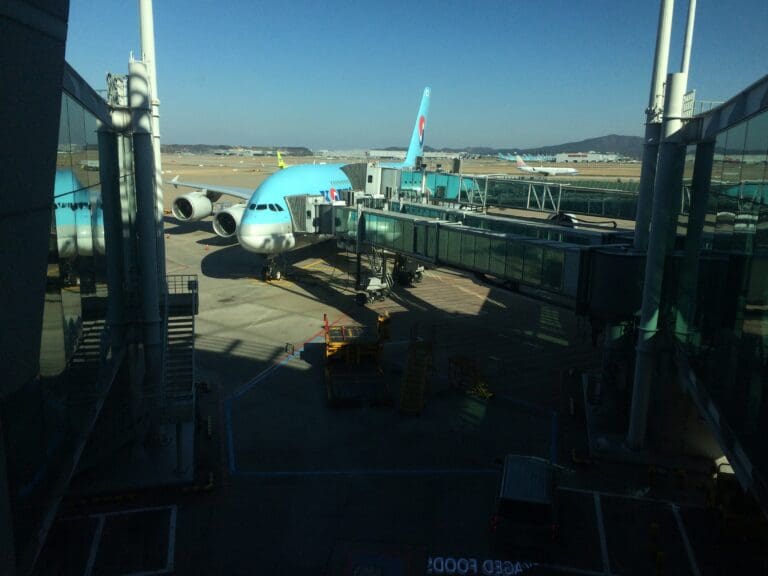My First Ever Antonov An-24 Ride: Almaty to Astana via Balkhash with Southern Sky Airlines
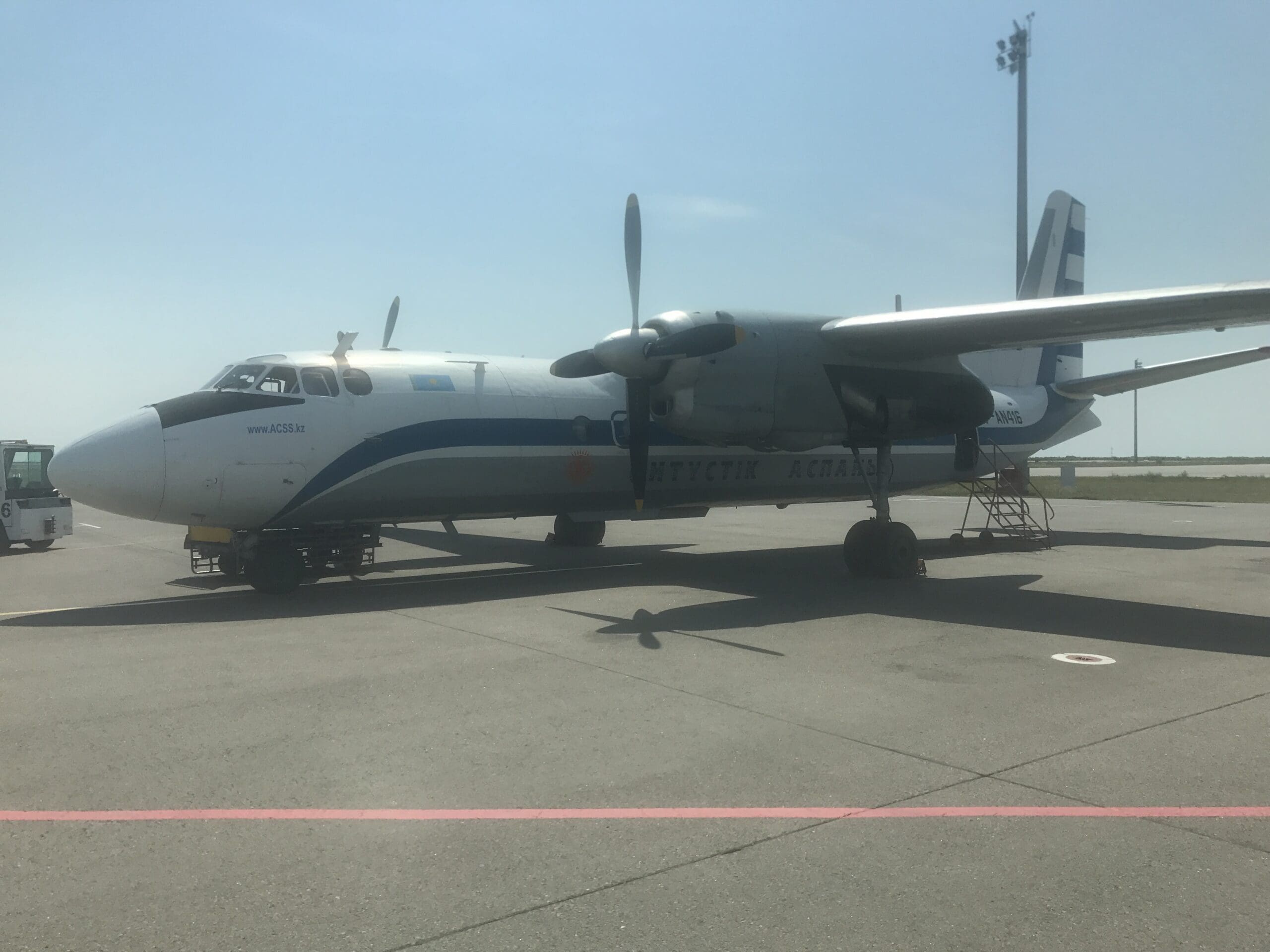
Background
Growing up in Britain during the noughties, I never imagined that I would get the opportunity to fly on a Soviet-era airliner. By the time I was hooked on aviation and had the concept of what constituted a rare aircraft type, it was already 2006. By this time, scheduled passenger services into the UK with such types were limited to a small number of screeching Tupolev Tu-154s operated by Balkan Holidays Air and Belavia. However, these were soon replaced by comparitively mundane Airbus A320s and Boeing 737 Classics. Nevertheless, the noisy growl of Soviet era cargo aircraft such as the Antonov An-12 and Antonov An-26 operated by a plethora of mostly Belarusian, Latvian, Russian and Ukrainian carriers could be heard on many night, with thease being frequent visitors to one of my local airports, East Midlands Airport. When I moved to Korea a number of years later, despite ‘sort of’ neighbouring Siberia, high ticket priced and overcomplicated visa requirements meant that my chances of flying onboard such aircraft were low and I never mannaged to make the trek up to Russia.
Then, in August 2017, upon returning to Britain at the end of my university year abroad, I managed to find myself passing through Kazakhstan. As Central Asia’s largest and wealthiest state, and being centrally located within the region, Kazakhstan is easily accessible from both across both Asia and Europe, whilst its visa-free policy for many nationalities and the low costs once in the country make it one of the cheapest places to fly onboard an Antonov An-24 (along with Ukraine thanks to Motor Sich Airlines’ venerable fleet of Soviet aircraft).
At the time of my trip in 2017, Southern Sky Airlines operated a fleet of Antonov An-24s on behalf of Kazakhstan’s second largest airline, SCAT Airlines. These were placed on routes in the East of the country flying to destinations including Almaty, Astana, Balkhash, Oskemen and Semipalatinsk. At that time the cheapest flight took the form of a short forty-minute hop between Oskemen and Semipalatinsk, costing just 3000 Kazakh Tenge (about $9) whilst the longest was a near two-and-a-half hour trek from Almaty to Semipalatinsk. All of these flights can be easily booked using foreign cards via SCAT Airlines’ website.
Wanting a reasonably long flight in the Antonov I considered the flight up to Semipalatinsk. However, I found that same-day connections back to Almaty were rather expensive. After some searching, I discovered that I could take an Antonov An-24 all the way up to Astana from Almaty with a forty-minute stop in the small city of Balkhash located on the northern shores of the lake with the same name. As these were two different flights, I would have to book tickets separately however as previously mentioned, booking these threw up no issues whatsoever, with each costing 14,000 Tenge, bringing my total fare to around $84, which I saw to be a good deal for three hours in a classic Soviet era airliner! That morning, my schedule would see me depart Almaty at 0910, arriving in Balkhash at 1035. Following a quick connection, I would rumble off at 1105 and touch down in Astana at 1250.
The Flight
The forty hours leading up to my arrival in Kazakhstan had been hectic. I had rushed to finish packing my things for my move from Seoul back to the UK after completing my degree’s compulsory year in Korea, and fearful of never seeing my deposit again, I frantically cleaned my room to a standard that not even soldiers can achieve. I then took a slow Mugunghwa train service across South Korea to Daegu from where I hopped over to China with Jeju Air and spent a sleepless night in Beijing Airport before heading eastwards to Xi’an on a China Southern Airlines Airbus A321. Once there, I managed to grab about three hours of sleep at the onsite airport hotel before flying over to Almaty on a beaten-up and battered SCAT Airlines Boeing 737-500. Thankfully, having booked a three-night stay at the Aksunkar Hotel which sits just a very short walk away from the terminal, I did not have far to go before bedding down for the night. Despite the rock-hard bed, I managed to fall asleep almost instantaneously before waking up at 0500 the next morning, my body still on Korean time and thus convinced that it was 0800. Whilst I found the Aksuntar Hotel to be reasonably clean and sufficient enough for my stay, it was a little spartan and definitely in need of a refit. Furthermore, having booked the cheapest possible room, this lacked its own bathroom, with cold communal showers and toilets located at the end of the corridor. After a shower, I had a quick and unhealthy breakfast consisting of some ramen that I had purchased the previous day before I headed down to the ground floor ready to commence a busy day of travelling through the skies of Kazakhstan.
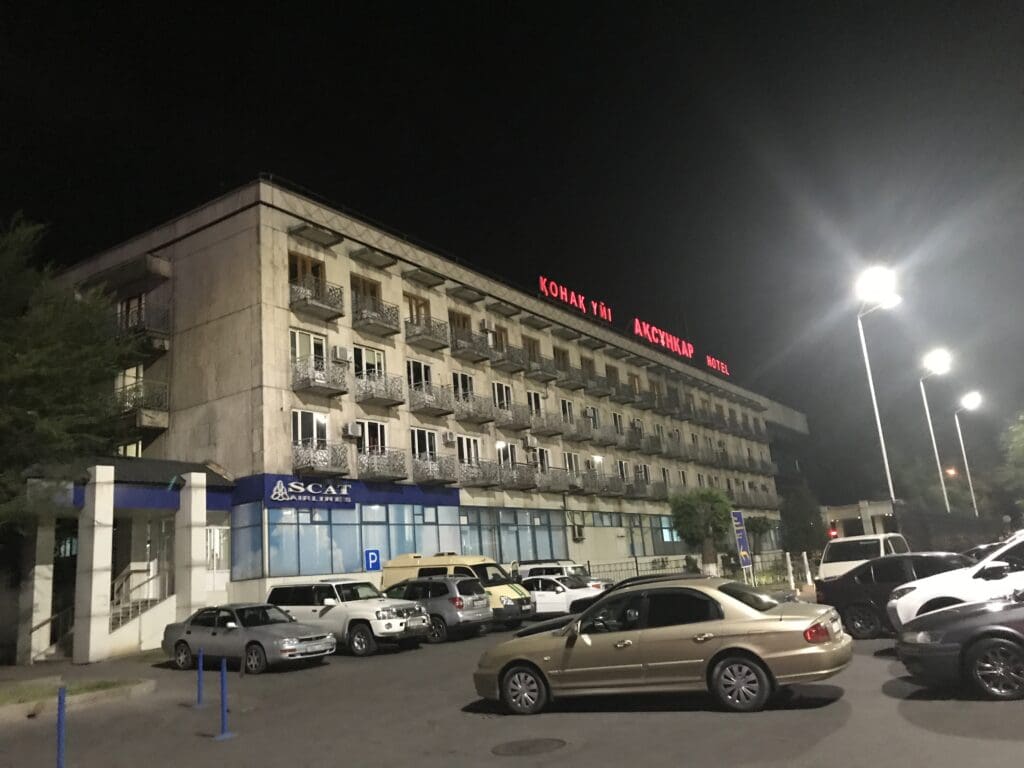
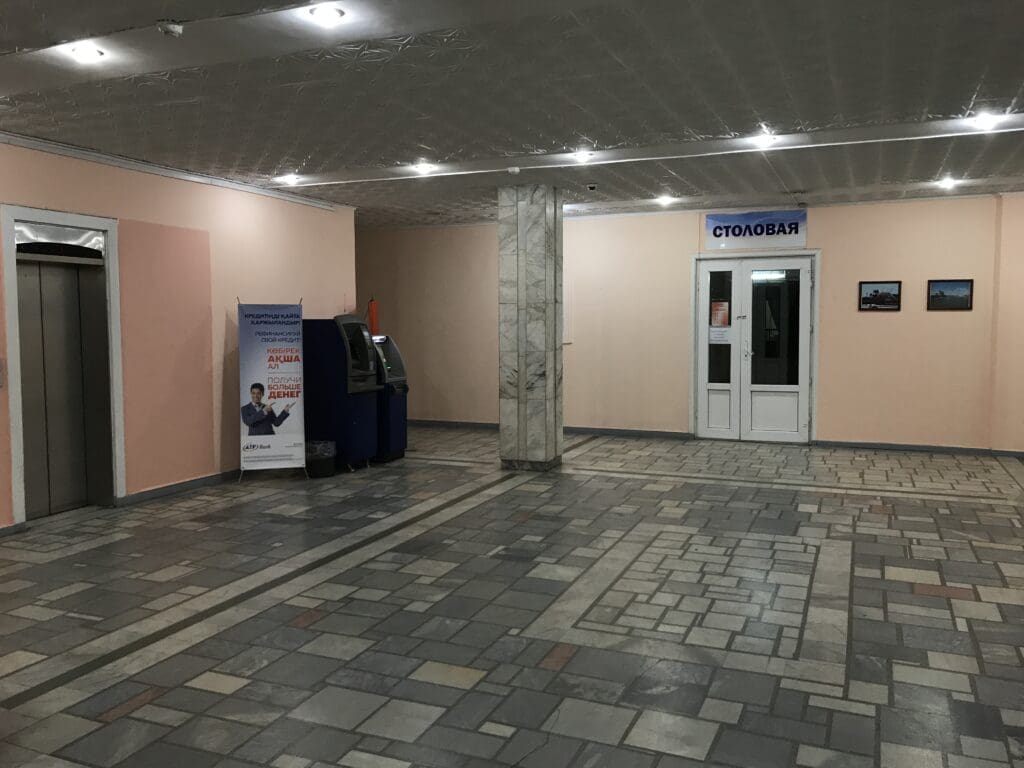
Once out of the hotel, I made a short walk through the refreshing summer morning air and arrived outside the entrance to the ground floor arrivals level no more than three minutes after leaving the hotel. As I have found to be the norm across many former Soviet states, a quick check was required before entering the terminal and once through I made my way up the escalators to the terminal’s departure level which sits on the first floor of this. Check-in for all domestic flights takes place in a relatively small, square-shaped area located just off the main waiting area. At that time, the check-in area was jam-packed with all manner of passengers from both Kazakhstan and abroad checking in for Air Astana, Bek Air, Qazaq Air and SCAT Airlines flights to destinations across Kazakhstan. Fortunately, of these airlines, SCAT Airlines appeared to be the least popular and I proceeded to join the relatively short queue leading up to one of the airline’s three desks. Still with a fair amount of time to go until departure, unsurprisingly I was promptly turned away and advised to return to the desk ninety minutes before my flight’s departure. Eventually, the three screens above these desks each changed to show the three different SCAT Airlines departures around 0900 – a Boeing 737-500 operated flight to Oskemen, the long Antonov 24 flight to Semipalatinsk and the shorter flight to Balkhash. Interestingly I noticed that whilst tickets for the latter two flights were sold through SCAT Airlines with the airline’s DV flight numbers only. At Almaty Airport, the flight numbers for these two flights were always displayed with the Southern Sky ‘BXA’ prefix and all announcements for these flights referred to the flights as ‘Southern Sky Airlines flight….’. Whilst my awareness of the peculiarities surrounding these flights ensured that this didn’t catch me out, I cannot help but think that this perhaps held the potential to cause some confusion for other travellers from abroad.
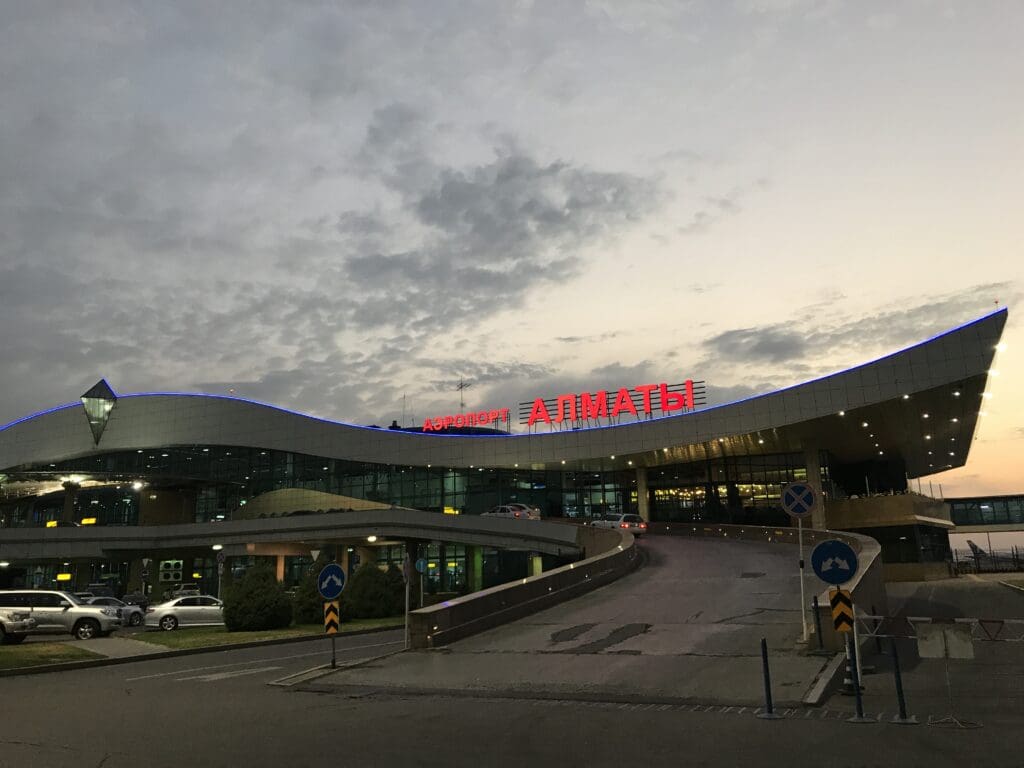
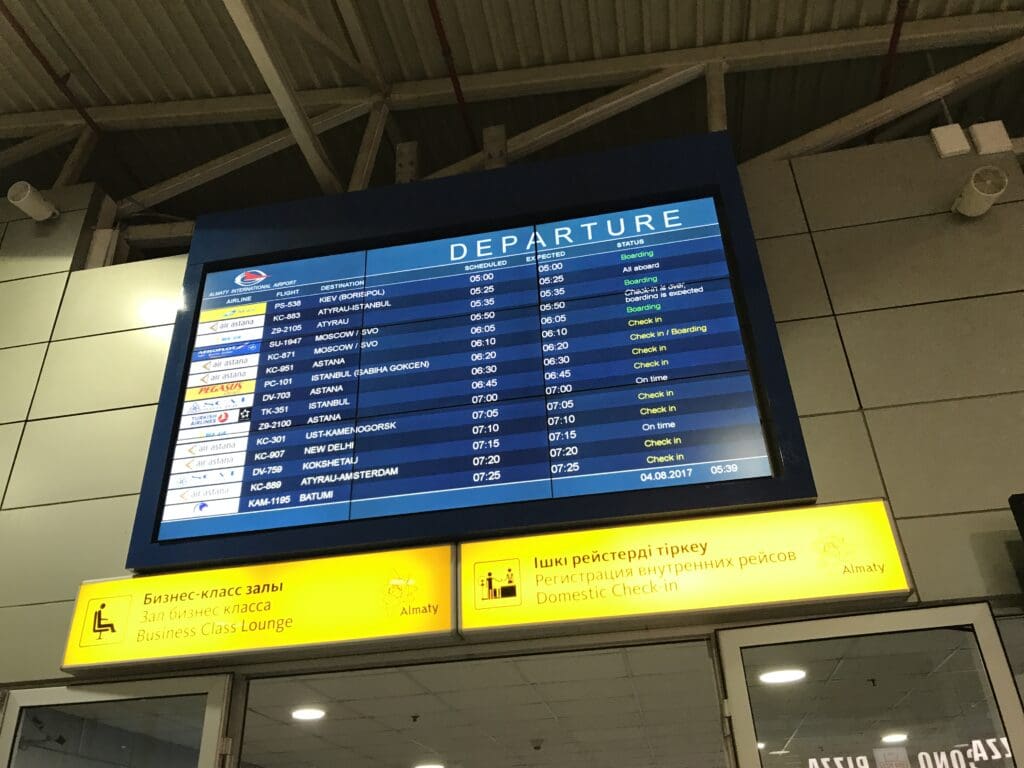
Once check-in opened, I managed to end up near the front of the short Balkash and once at the front, I was greeted in Russian. As I had expected, having rejected the many direct flights between Kazakhstan’s two largest cities, the check-in agent was a little surprised about my itinerary. After informing me that she would only be able to check me in for the first leg of this journey, I was asked whether I would like an aisle or window seat. After choosing the latter, a very bland-looking boarding pass lacking any branding or advertisements was printed off and I was advised to head through security, the entrance to which is located on the opposite side of the small check-in area. Seeing as the airline’s website claims that check-in closes forty minutes before each flight, the exact amount of time that I would have between flights at Balkhash, the fact that I was unable to check in all the way up to Astana was a little worrying. However, not expecting Balkhash Airport to be any massive super-airport comparable to the likes of Beijing, Dubai or Heathrow, I did not expect the journey from aircraft to the check-in area and back airside to take any major length of time. Furthermore, if all went pear-shaped, I could always spend a few hours at Balkhash and purchase a new ticket back to Almaty on the airline’s afternoon flight.
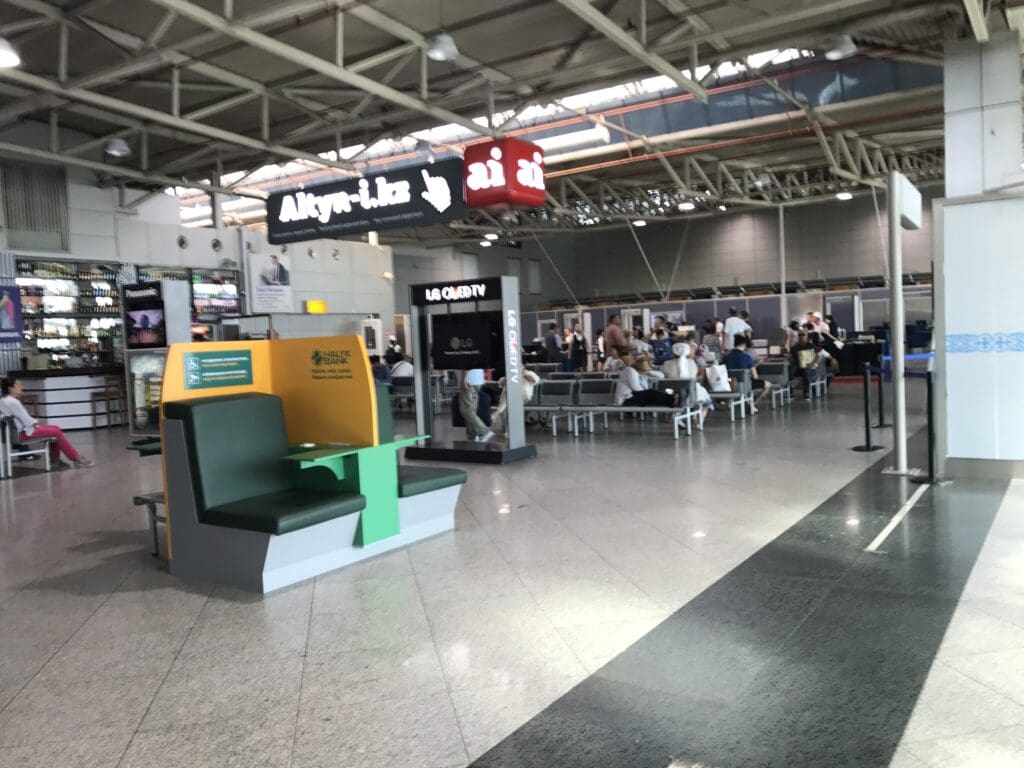
With the morning rush in Almaty having ended by the time I had checked in, passing through security was a breeze, with no queuing required and I managed to sail through this without the need for any additional checks to be made. Before I knew it, I was free to explore Almaty Airport’s landside area. Despite serving Kazakhstan’s largest city and former capital, Almaty Airport’s terminal is relatively small and is comprised of three waiting areas – a larger hall that passengers immediately enter once through security, a slightly smaller hall that sits above the domestic arrivals area and is accessible via a bridge from the main area and a small area on the ground floor that serves the bus boarding gates. Seeing as my flight would depart from a remote stand, after a quick wander around I headed down to the ground floor waiting area which was full of passengers heading off on SCAT Airlines’ aforementioned three services. This part of the terminal was relatively crowded although I was able to nab one of the last remaining free seats.
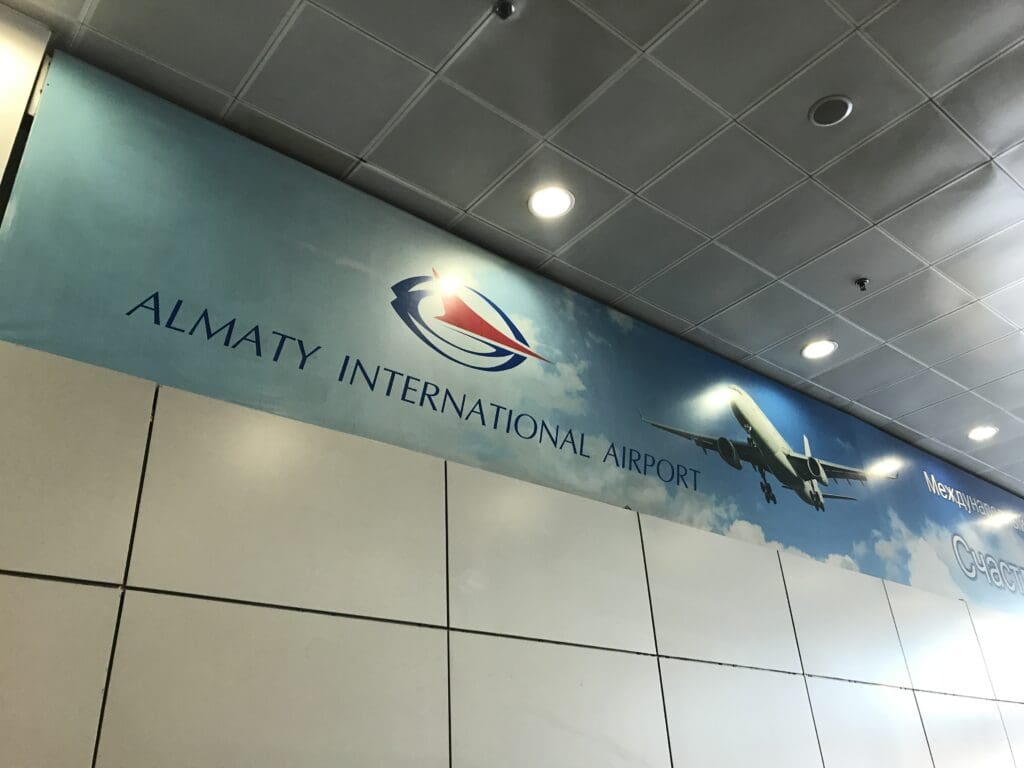
At 0840, boarding for the 0920 Boeing 737 service to Oskemen was called which resulted in a mass exodus of passengers, allowing for a slightly more calm and comfortable wait. Meanwhile, outside, the distinctive whine of a Fokker 100’s Rolls-Royce Tay engines could be heard as an example from Bek Air taxied past, commencing its journey across Kazakhstan to the city of Aktau in the west of the country. In the distance, a slightly more modern airliner could be spotted in the form of a Hong Kong Airlines Cargo Airbus A330 Freighter which was beginning its journey to Istanbul following a mid-journey stop during its trek from Hong Kong. Five minutes after boarding for the flight to Oskemen had commenced, an announcement was made inviting all those bound for Balkhash to make their way to the gate and a small, orderly queue formed leading up to the gate podium. Soon, I had my boarding pass scanned by a cool agent and without a word, I stepped outside and darted onto the waiting bus.
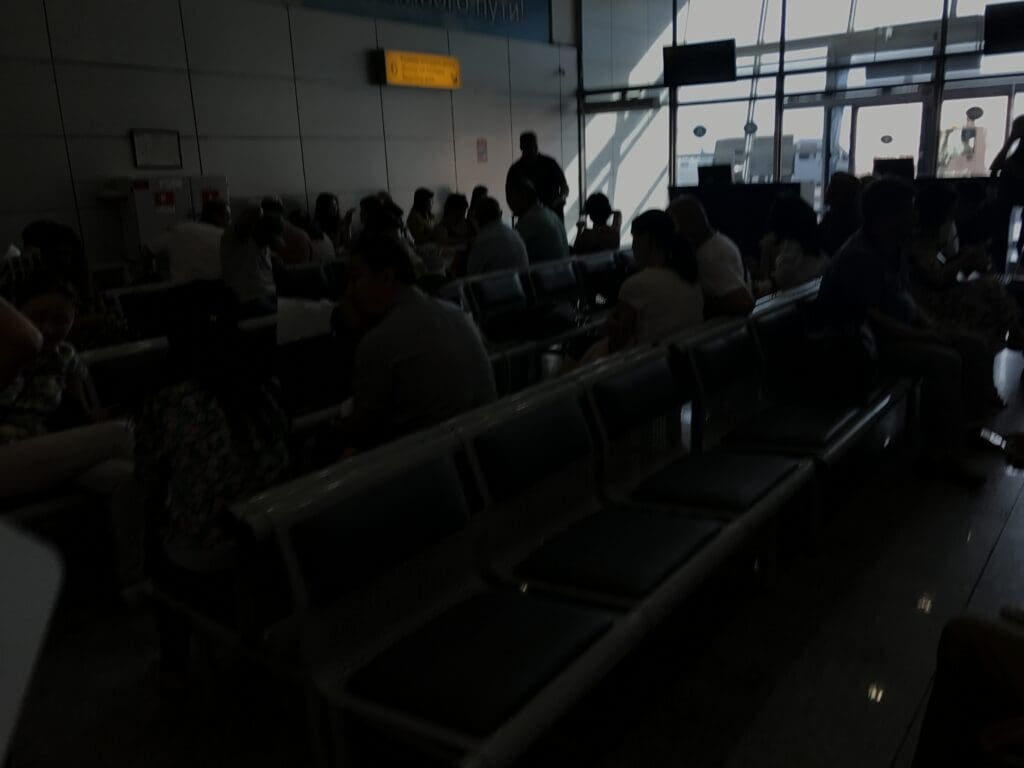
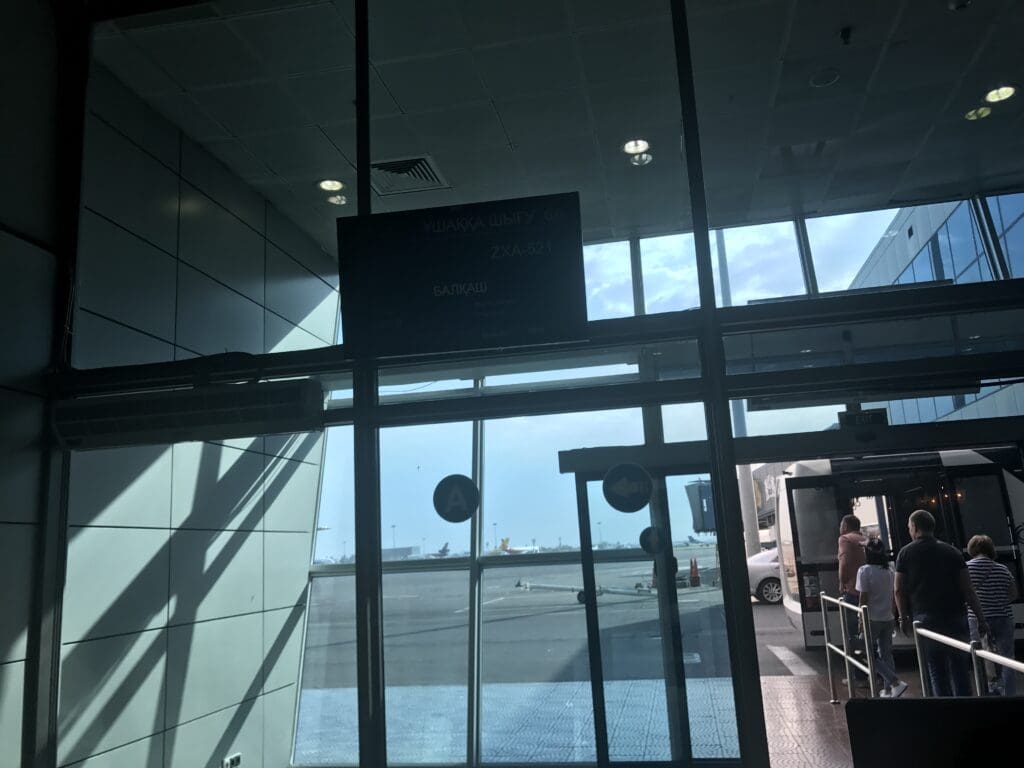
Within five minutes all passengers had made their way onto the bus, and, with no more than 25 passengers, the doors slid close and we were off! As we drove out to the aircraft, most passengers were near silent as if they had some nerves about the upcoming flight. Focusing on the passengers, the vast majority appeared to be passengers from Kazakhstan and were travelling with relatives up to Balkhash, although I did also notice several Russian nationals onboard the flight too. Turning my attention to the sights outside, once we had left the terminal, our bus drove past a Boeing 767-300ER operated by SCAT Airlines’ leisure subsidiary Sunday Airlines which was being readied for a flight to the popular Turkish holiday spot of Antalya. This was followed by a line-up of modern Air Astana aircraft that included one of the airline’s latest additions, an Airbus A320neo.
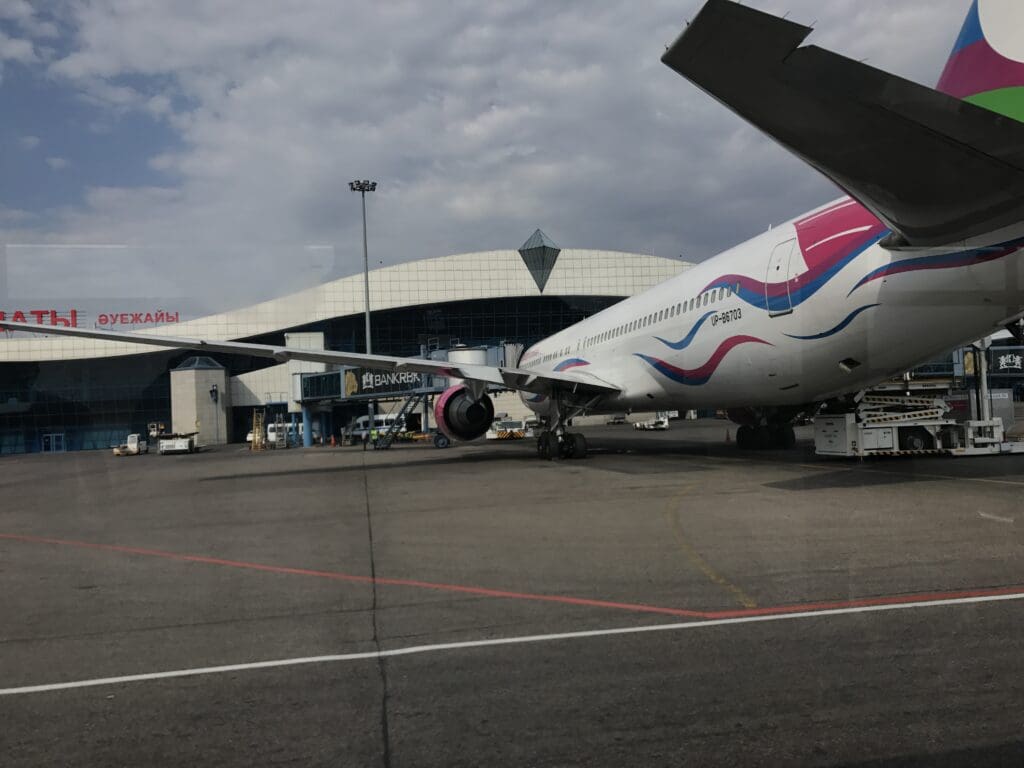
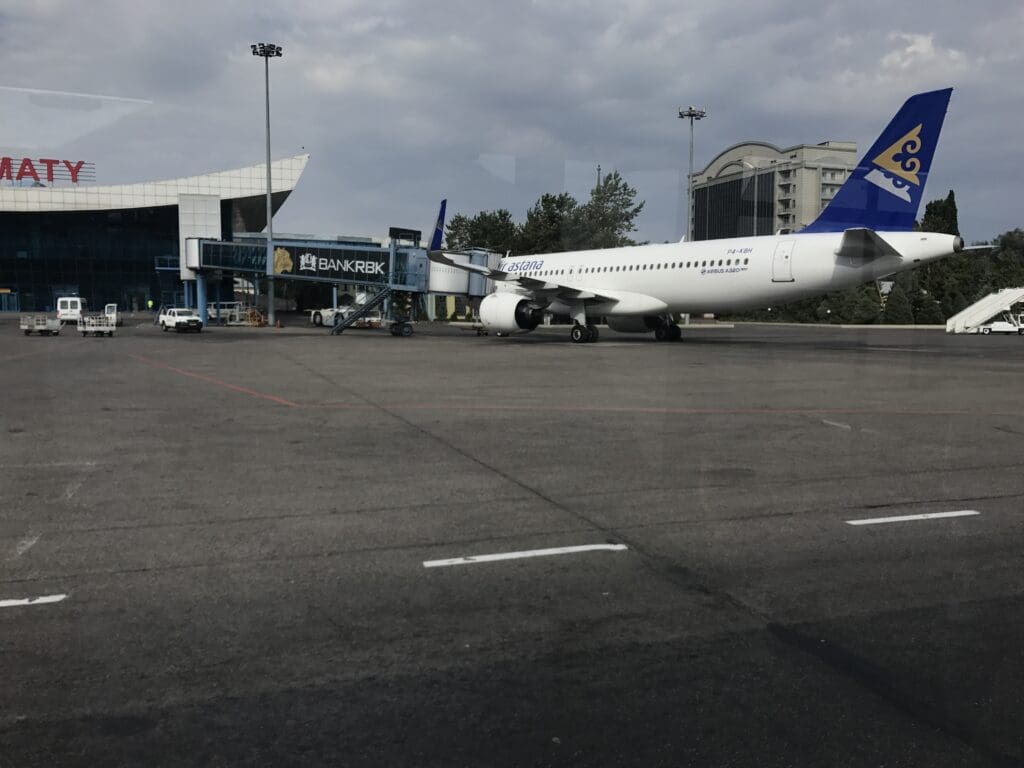
Upon leaving the terminal behind, the bus darted across to the remote stands near the airport’s VIP terminal where two pairs of turboprop airlines could be seen, the first was a pair of modern, shiny and pencil-like Qazaq Air Dash 8 Q400s painted in the carrier’s minimalistic, mostly-white livery. The second pair took the form of robust, veteran Southern Sky Antonov 24s painted in the classic livery consisting of a grey underbelly, white fuselage and a blue stripe, a colour scheme that is sadly becoming a rarer sight across the world’s skies. Hinting at the aircraft’s owner, ‘Оңтүстік Aспаны’, meaning Southern Skies in Kazakh is painted in dark blue with a traditional pattern printed onto this. The only sign of the 21st century on these aircraft came in the form of the inclusion of the airline’s website address which had been applied beneath the cockpit window.
After passing the first Antonov which was in the process of being loaded up with catering for its long flight up to Semipalatinsk, it became clear that the second Antonov was the one that would be taking me up to Astana. This aircraft was UP-AN416, a 43-year-old Antonov 24RV that had spent its entire life flying around Kazakhstan, first with Aeroflot as CCCP-46672 before being passed onto Kazakhstan Airlines following the collapse of the Soviet Union. After the Charkhi-Dadri mid-air collision in November 1996 and the consequent declaration of bankruptcy of the airline, the aircraft was then passed on to Air Kazakhstan where it continued to fly until that airline too became bankrupt in 2004. After this, the aircraft was then flown with SCAT Airlines as UN-46672 before being registered in 2008 as UP-AN416. In November 2014 when SCAT Airlines removed all remaining Soviet era from its fleet, the aircraft was transferred to Southern Sky Airlines but continues to operate for SCAT Airlines. There is one significant incident reported for the aircraft, when in February 2013, the aircraft rolled off the runway after landing in Almaty. As we pulled up at the aircraft, three senior-looking uniformed cockpit crew members stood chatting around the tail, admiring the aircraft that they would operate through the skies of Eastern Kazakhstan that day. After the bus doors opened, passengers filtered out and soon queued to board the aircraft. As I stood near the port horizontal stabilizer I noticed a winged A (an old Antonov logo perhaps?) next to which was painted ‘No. 9604’, part of the aircraft’s construction number, beneath this ‘ANTONOV 24RV’ was written confirming the aircraft type. Both of these were barely visible as they were painted in black and blue respectively onto the aircraft’s dark blue cheatline.
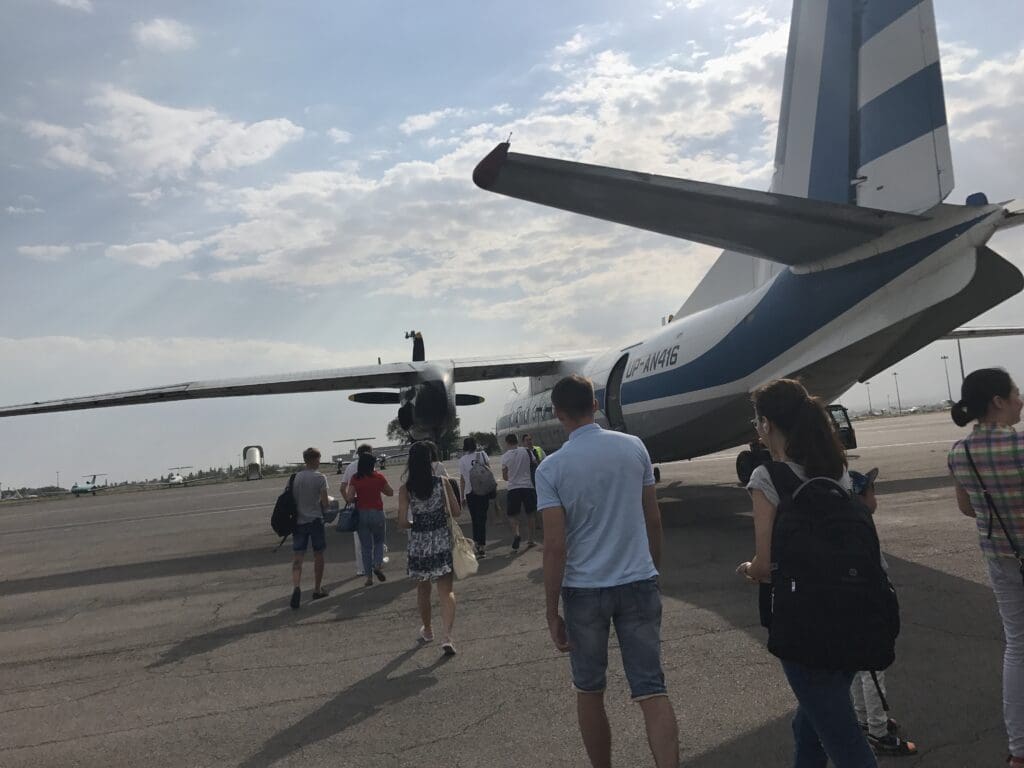
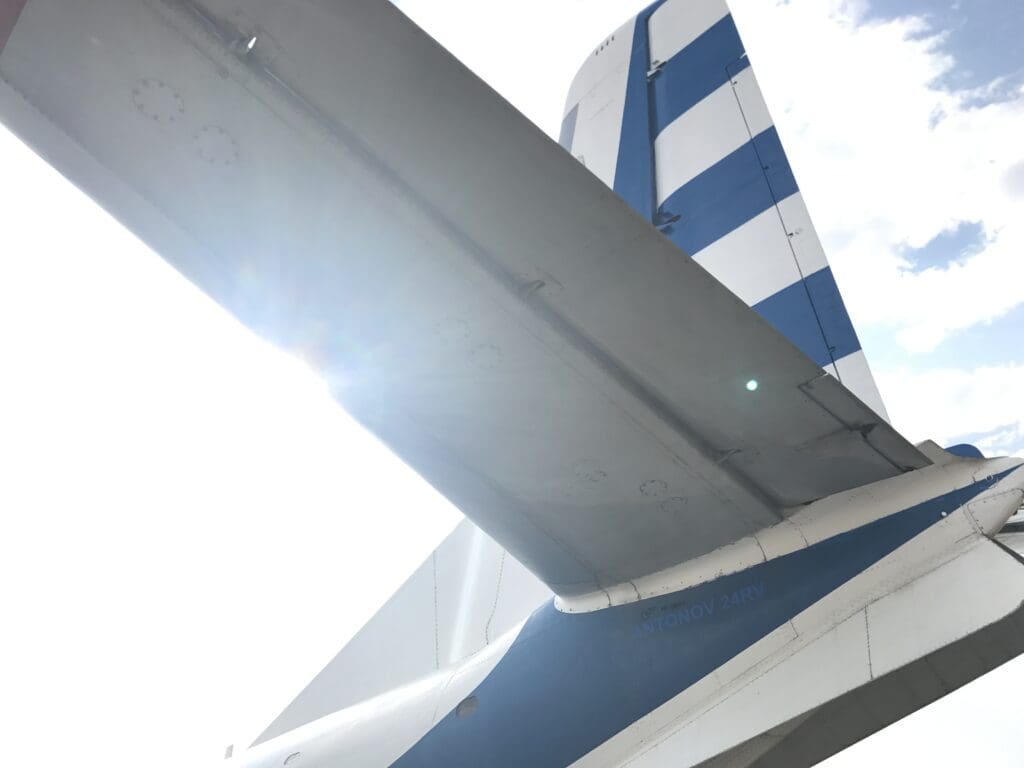
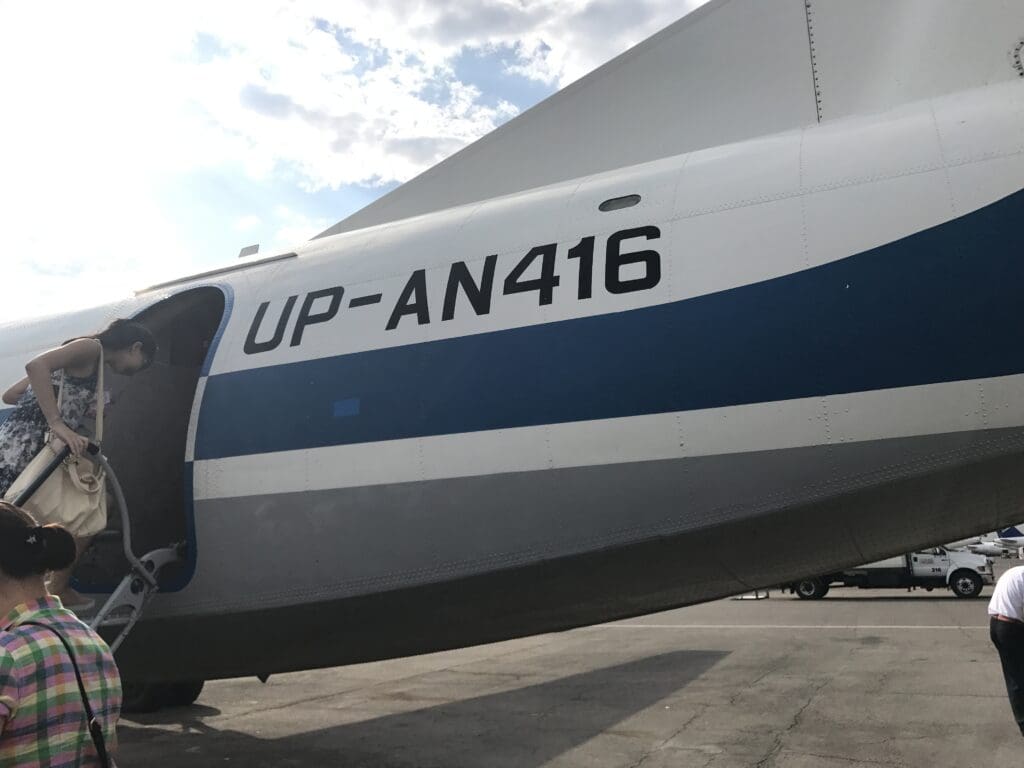
Comparing this to the Xian MA60, a type that I had been fortunate enough to fly several months before this trip, unsurprisingly I noted several distinct similarities. On both, steps were protected on only one side with a single handrail leading up to the low entrance door (the dimensions of which appeared to be the same). As with the MA60, upon boarding passengers are met with a spacious area at the rear of the aircraft accompanied by the strong oily scent usually associated with vintage museum-piece aircraft.
Once onboard, I was greeted in Russian by the flight’s sole flight attendant, a tall, thin gentleman who appeared to be far younger than the aircraft. After a moment of waiting I headed into the cabin that thankfully appeared to have only gone minimal renovations throughout the aircraft’s life. On the cabin walls, worn-looking leather replaced the usual plastic panelling whilst large, circular bulging windows ran along the cabin with curtains provided for those who did not want to spend the journey gazing out at Kazakhstan’s diverse landscapes. Small circular call buttons were located above each window, however, there was little signage indicating their function. Perhaps one of the most surprising features of the cabin was the mirrored ceiling above the aisle which ran the length of the aircraft, allowing for bird’s eye views of those passengers seated in the rows in front of mine. The second most surprising feature took the form of the richly patterned albeit somewhat faded and worn carpets that ran the length of the main cabin. To summarise, this aircraft was most certainly unlike any that I had flown before!
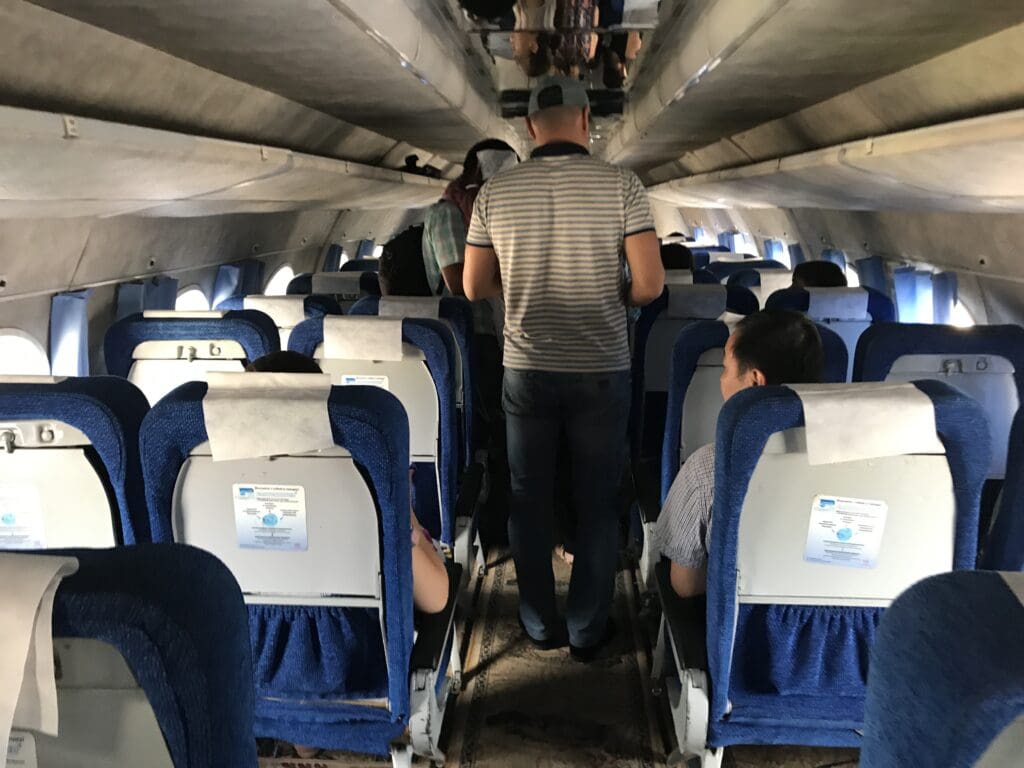
Before long, I reached Row 6 and placed my bag on the exposed hat rack up above before sliding into the large and well-padded blue fabric-covered seat that I would be calling home for the next hour or so. Whilst the seat itself was comfortable, the legroom was most certainly not, however, this was tolerable given the relatively short length of the flight up to Balkhash. Having spent the night on the ground in Almaty, the aircraft appeared to be spotlessly clean, however, given the age of the aircraft, I was not surprised to see that the interior looked a little tired and battered, with plenty of scratches and marks both on the tray table in front of me and window. Turning to the seat pocket, this contained a SCAT Airlines branded sick bag and a Southern Sky Airlines safety card alongside a copy of Kazakhstani aviation magazine, Sky, this featured articles on a range of topics related to the nation’s aviation industry in English and thus proved to be an interesting read.
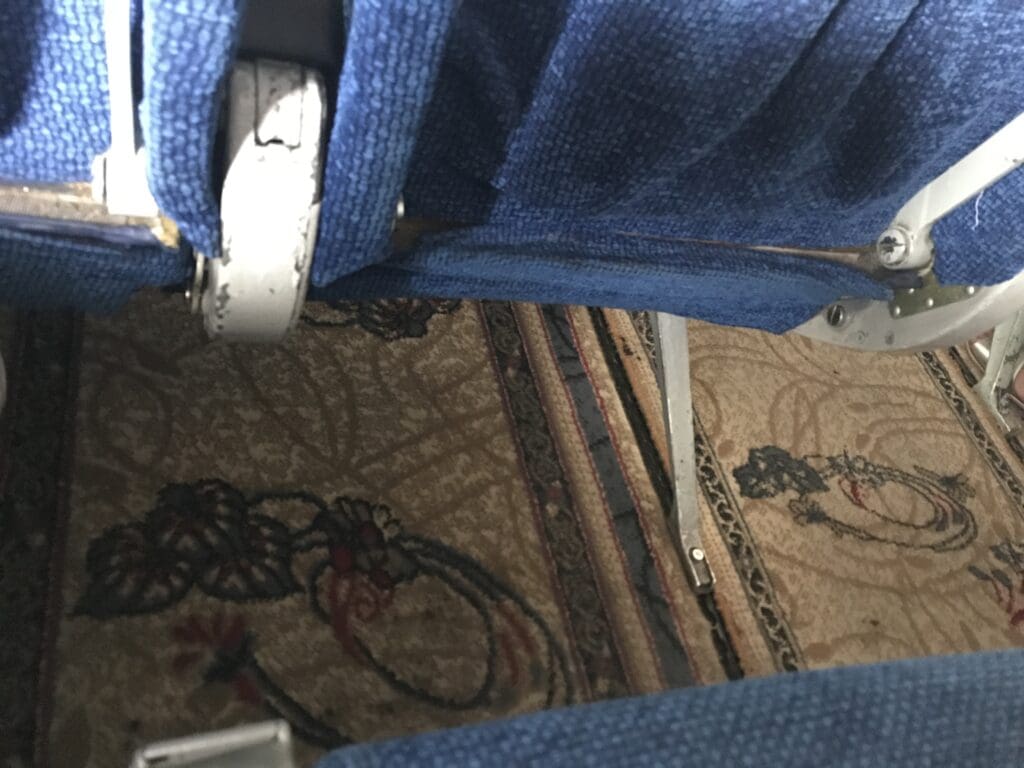
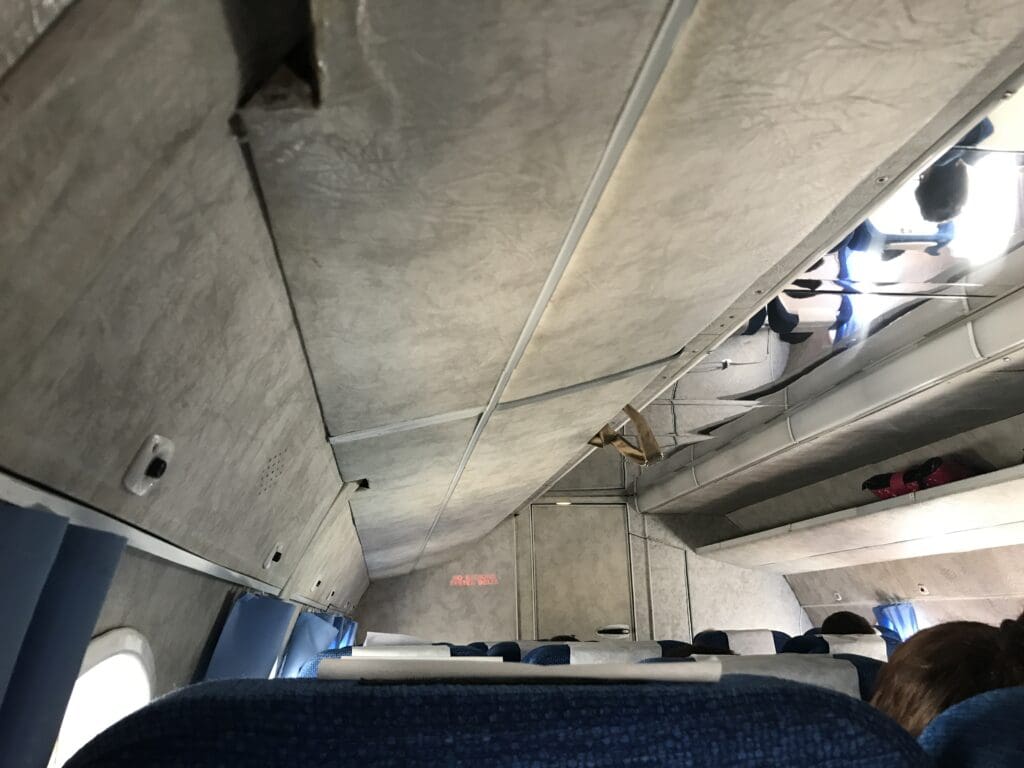
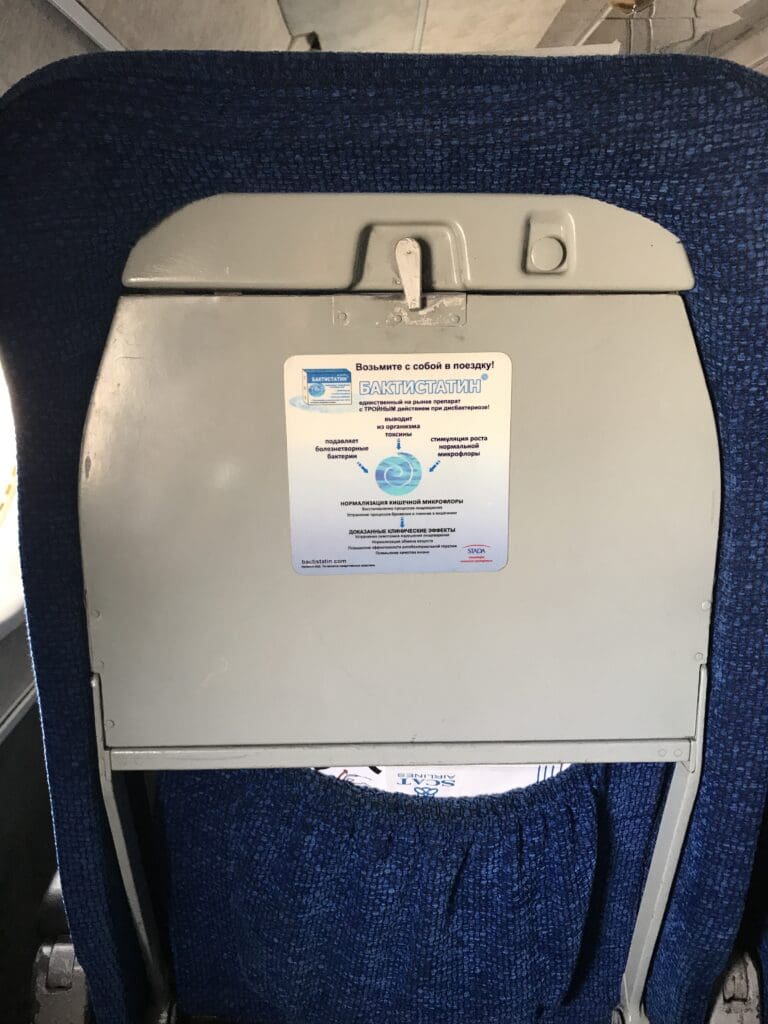
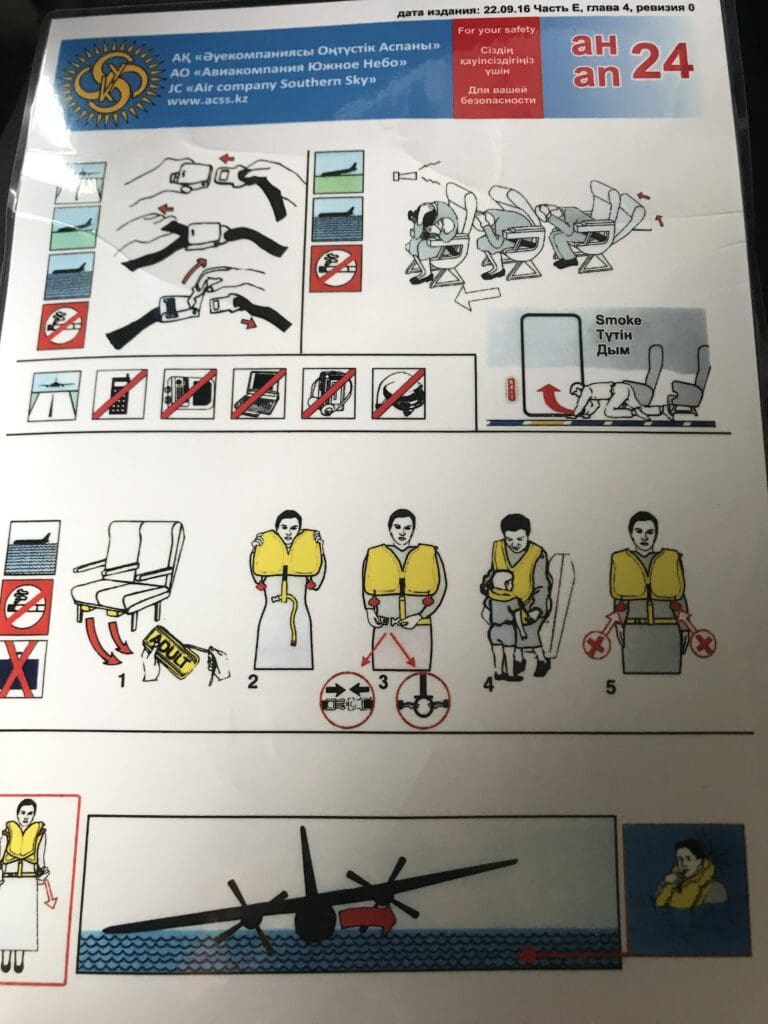
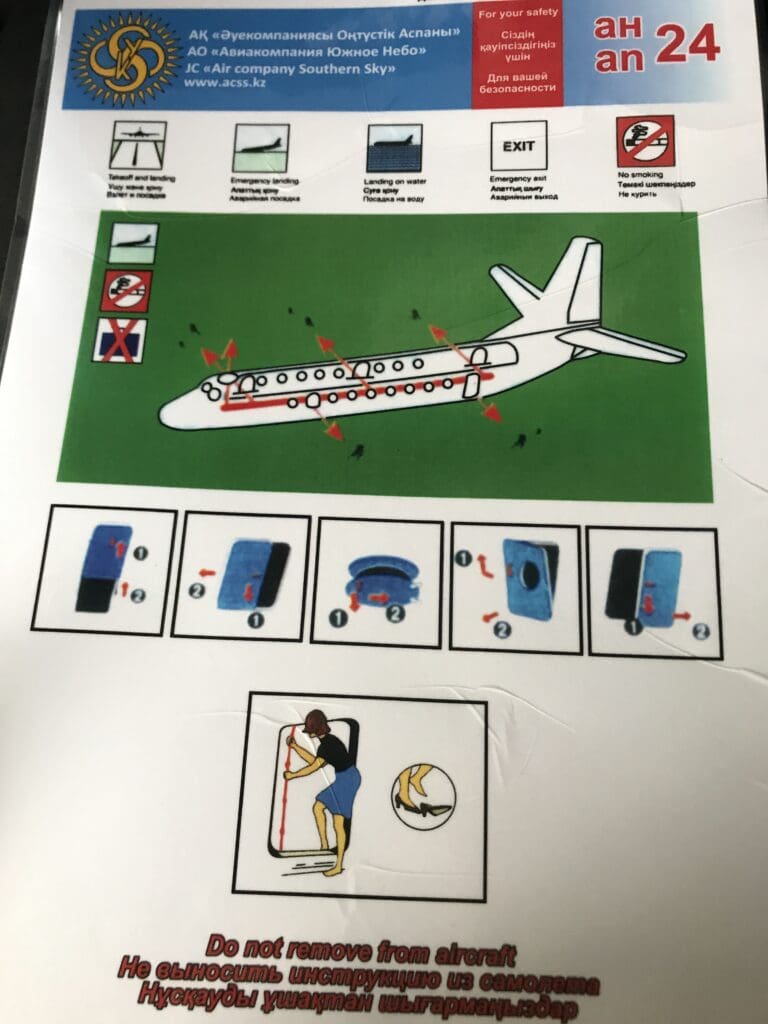
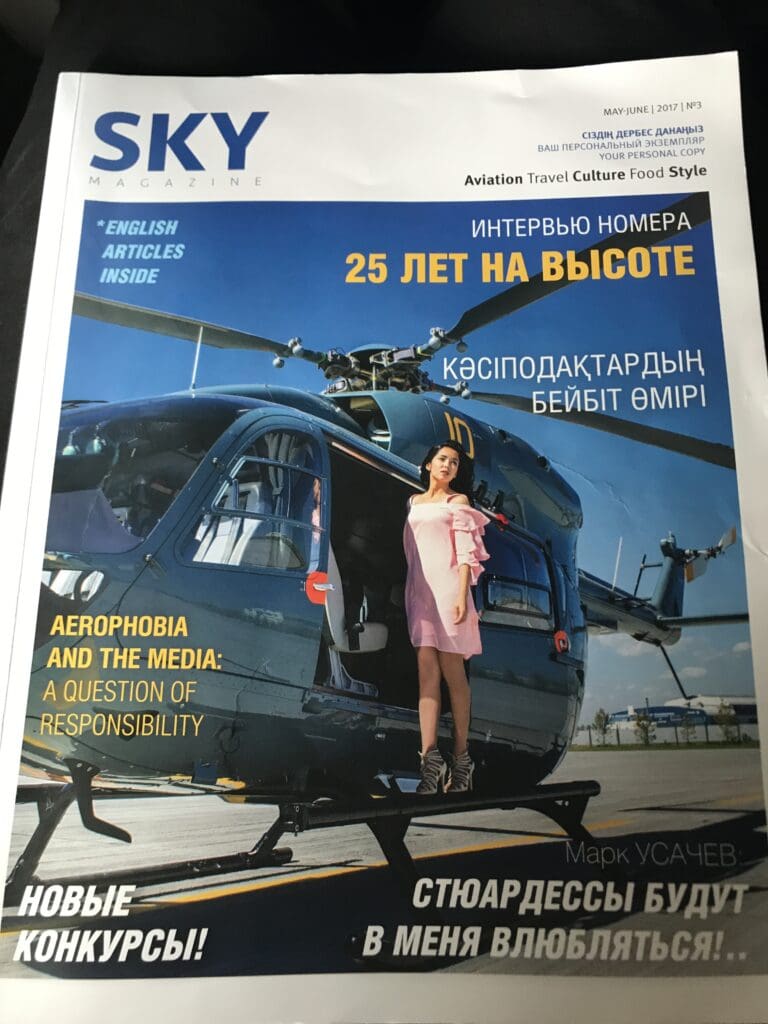
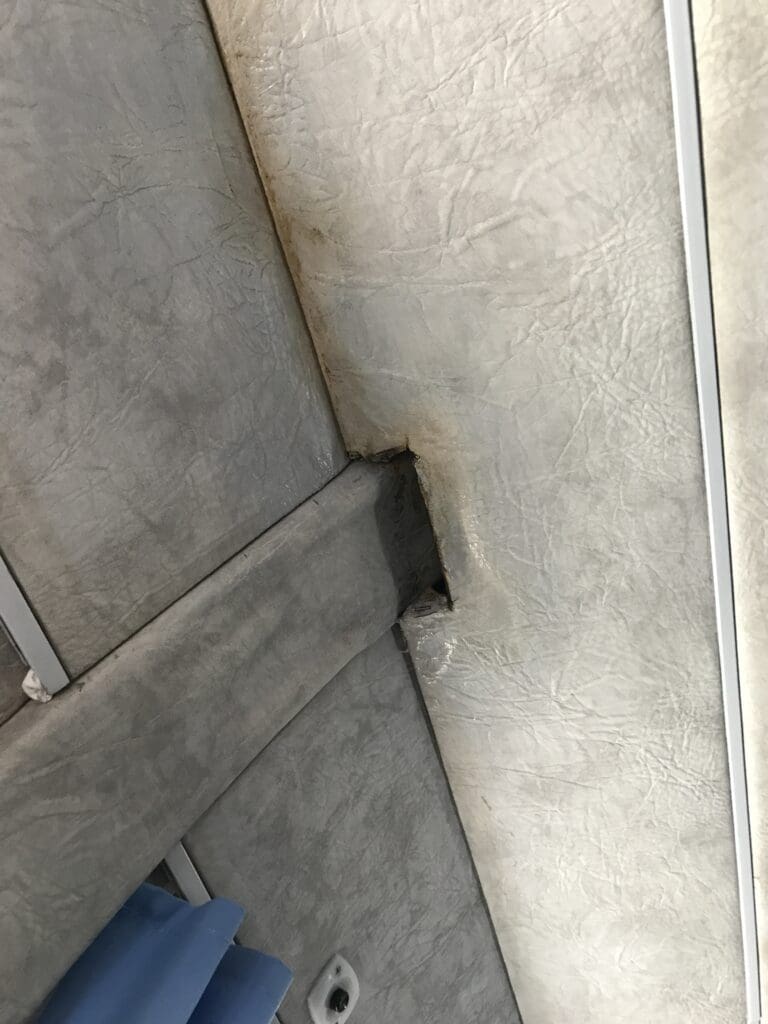
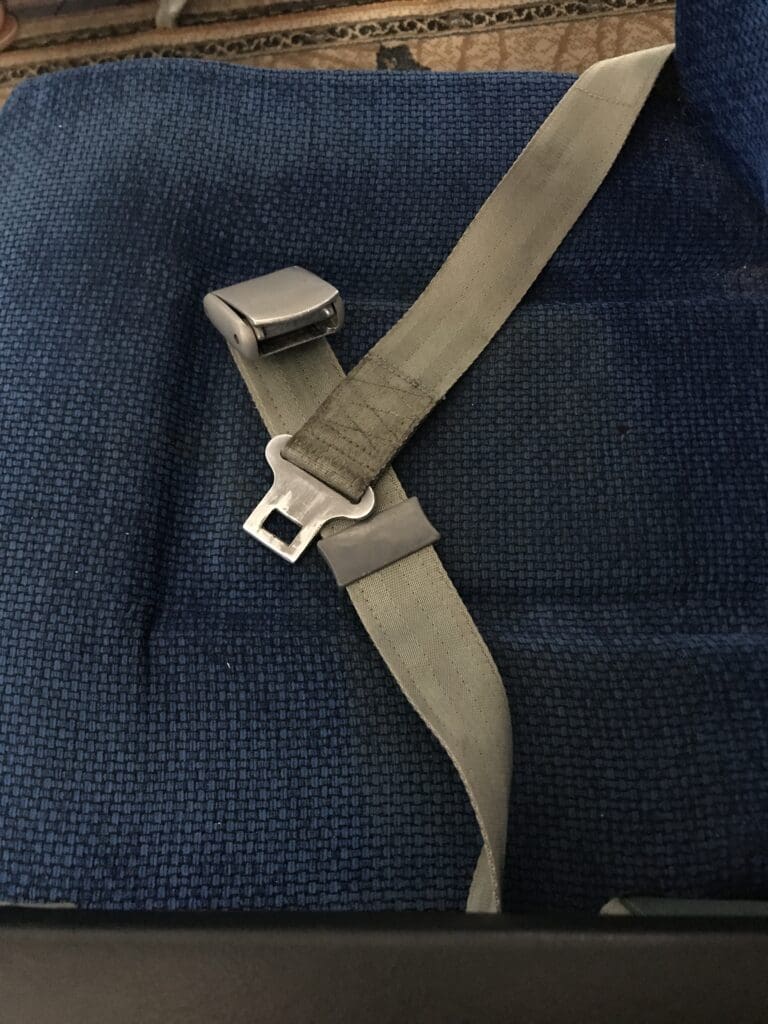
By 0900, all passengers had boarded the aircraft and taken their seats and so at this time the metal steps were retracted and the cabin door was closed with a large thud. In what was a nice touch albeit one that does seem to be particularly common across former Soviet states, soon, the flight attendant passed through the cabin with a basket of fruit-flavoured boiled sweets. Once this initial round of service had been concluded, they then took their position at the rear of the galley and conducted their welcome and safety announcement in Kazakh and Russian. Within five minutes of the cabin door being closed, the loud sound of the Antonov’s auxiliary jet engine filled the cabin before the two Ivchenko AI-24 turboprop engines nosily whined into life, followed by a fair amount of rattling and vibration as the four-bladed AV-72T propellers began to whirl into life. A few minutes after the two engines had fired up, the aircraft remained on stand for another few minutes before finally powering forwards and commencing its taxi to Runway 05L.
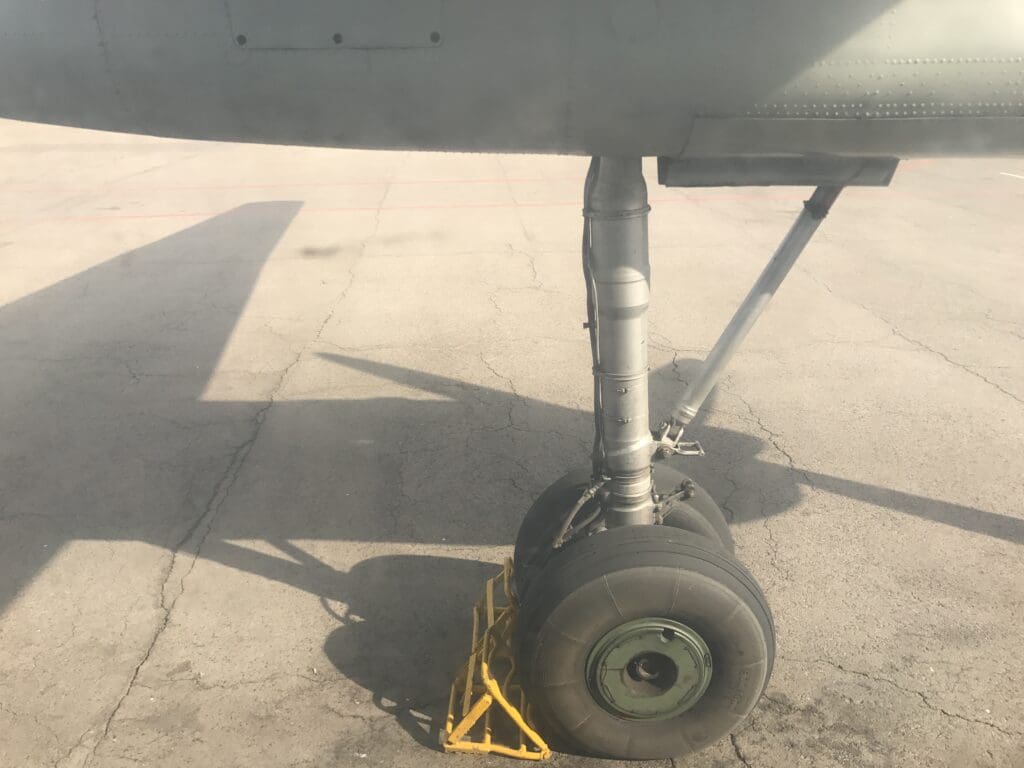
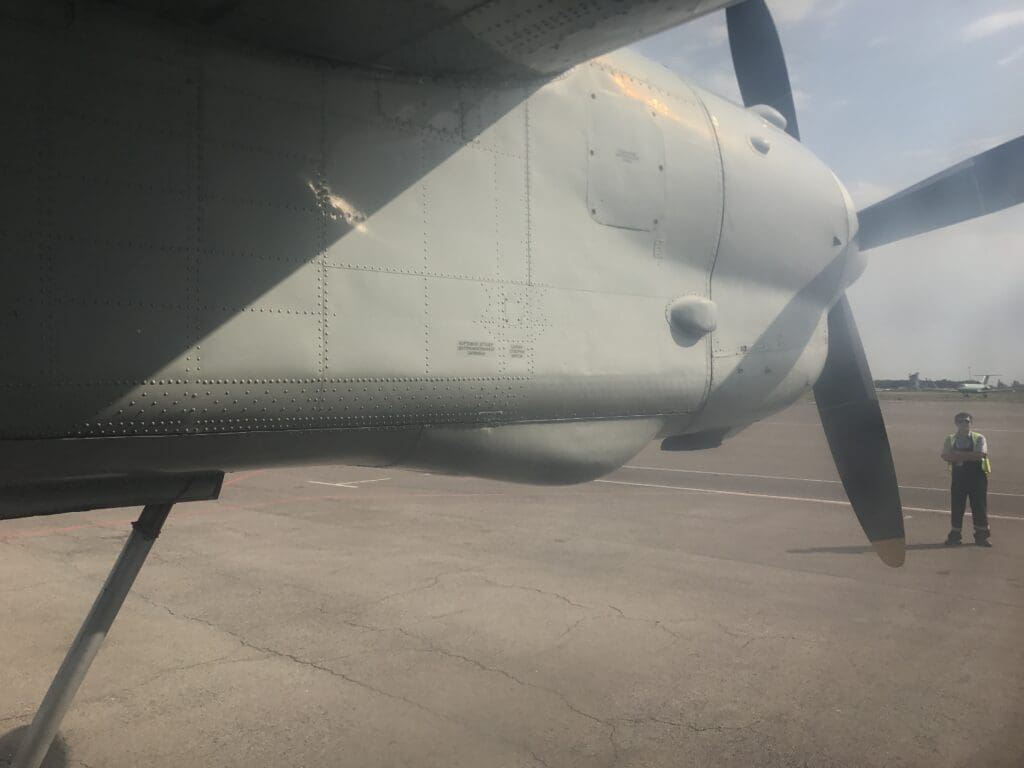
As we left the apron, the Antonov passed a cluster of some interesting business jets which included a corporate configured Tupolev Tu-134, although this was sadly stored and unlikely to fly again. Interestingly, during our taxi, the pilots seemed to be constantly adding and taking away power as if the aircraft was having trouble maintaining a constant taxi speed and thus ended up creating a rather noisy journey to the runway. Upon arrival at one of the holding points, the Antonov held for a couple of minutes during which time the two Ivchenko engines seemed to be spooled up before we made our way onto the runway where we paused once again. At 0915, the pilots pushed the power levers forward with the brakes held causing the cabin to be filled with a seemingly high level of vibrations before the brakes were released causing us to go flying down the runway with an amount of force that caused the passenger opposite me to cling onto their armrests for dear life!
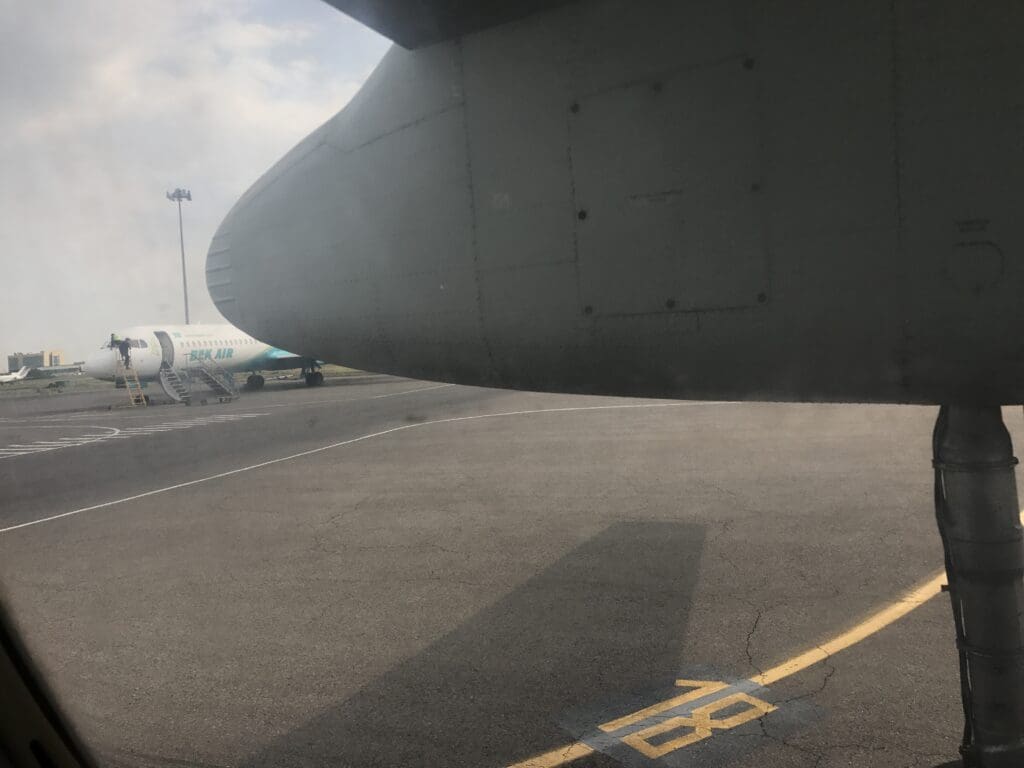
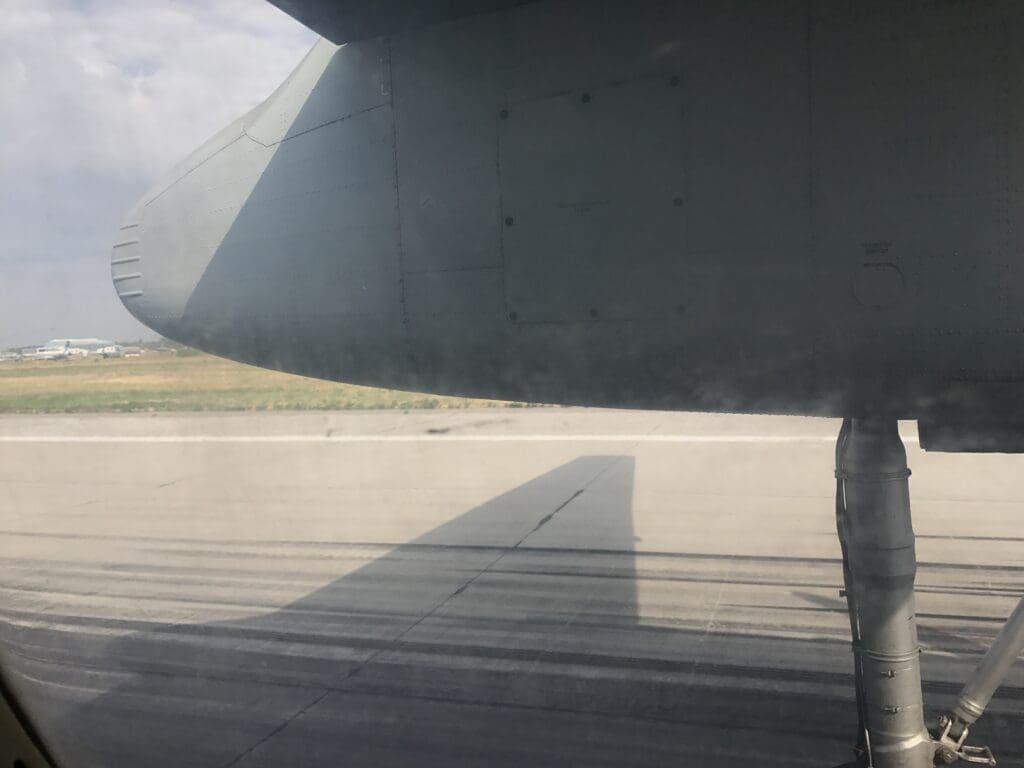
Despite the powerful take-off roll, the aircraft seemed to take quite some time to take to the skies and eventually, the Antonov was point skywards and we commenced what seemed to be a very shallow climb out over the green fields that surround the airport. As the Antonov continued its climb, we passed over the occasional town and village, each appearing to be home to an array of colourful houses. However, the highlight sight during our climb took the form of Baiserke Airfield where all sorts of light aircraft types that included plenty of Antonov An-2s could be seen on the ground. Eventually, the green faded to a sandy grey colour as we continued northwards away from Almaty, with little to be seen below other than the occasional colourful lake.
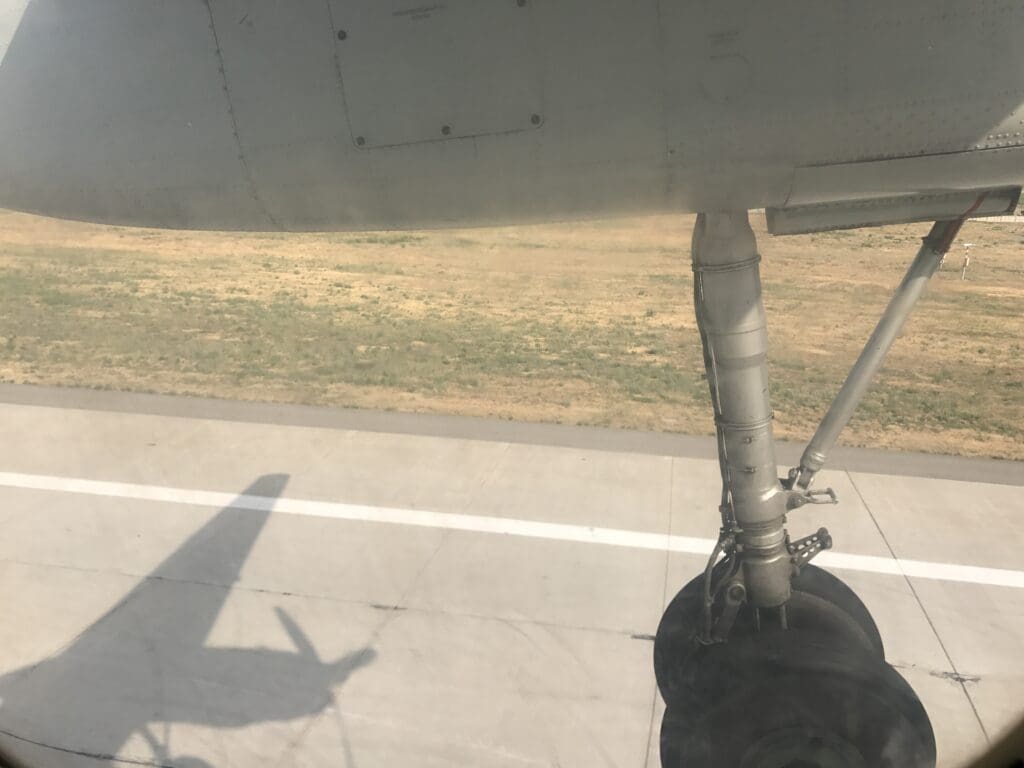
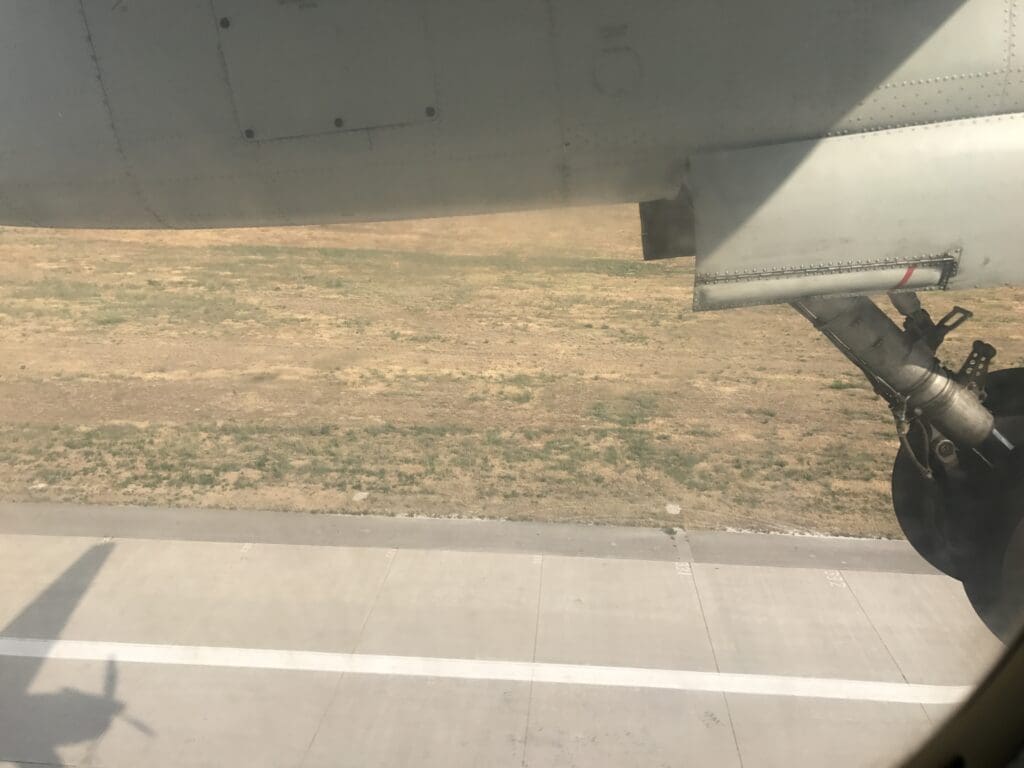
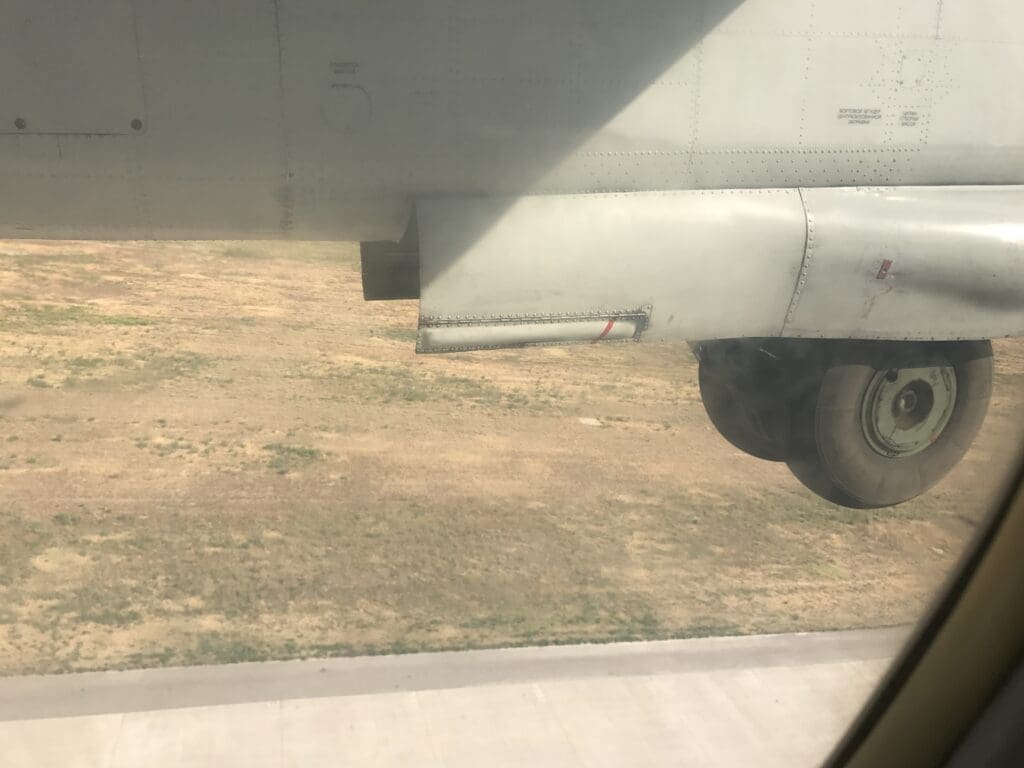
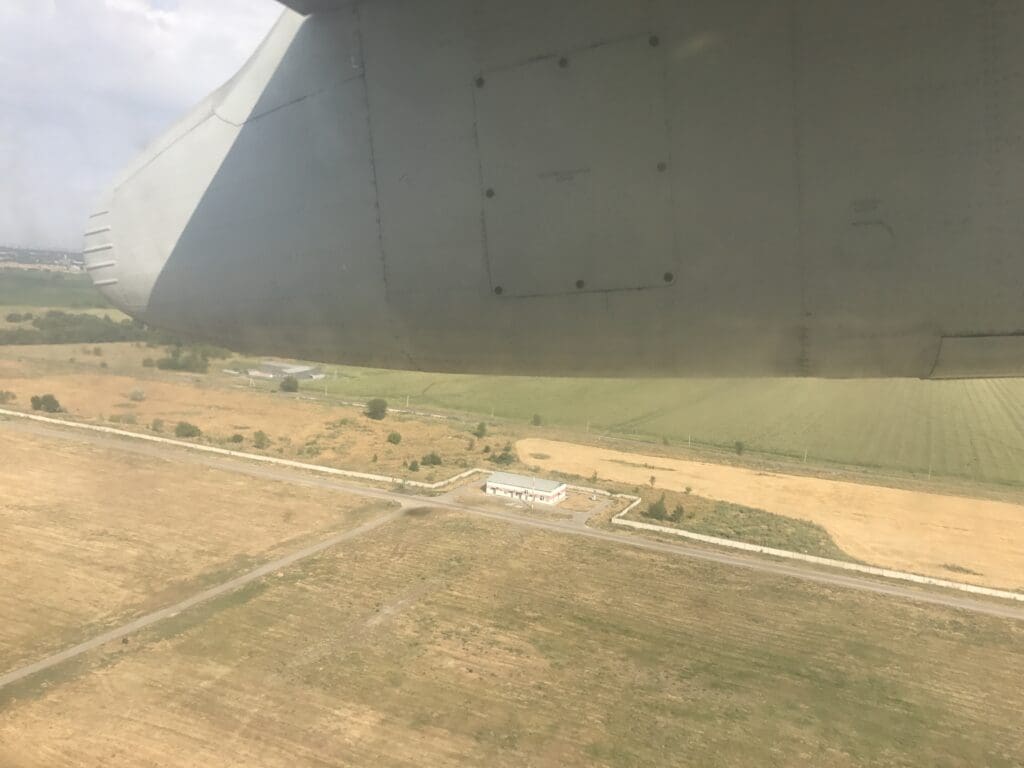
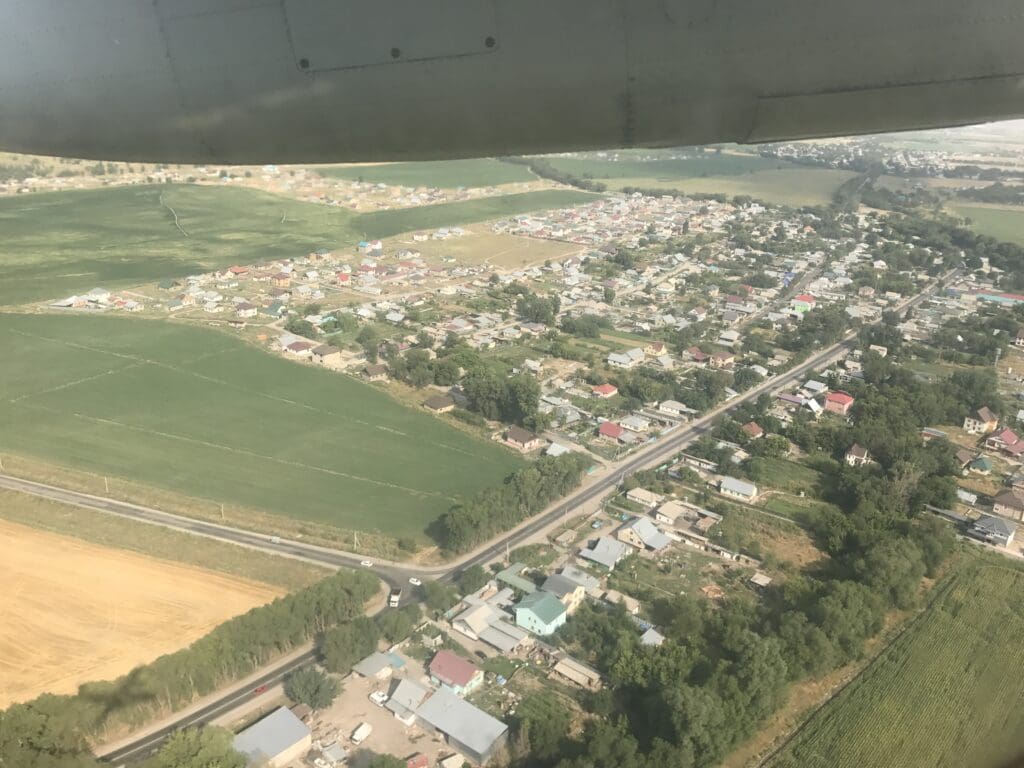
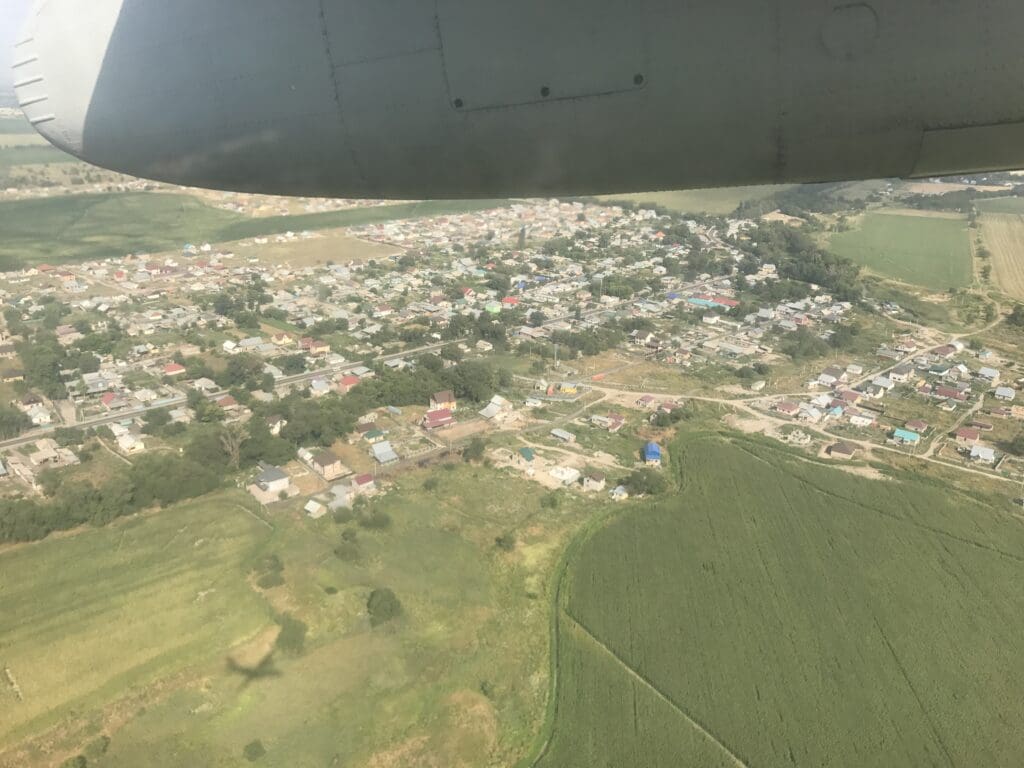
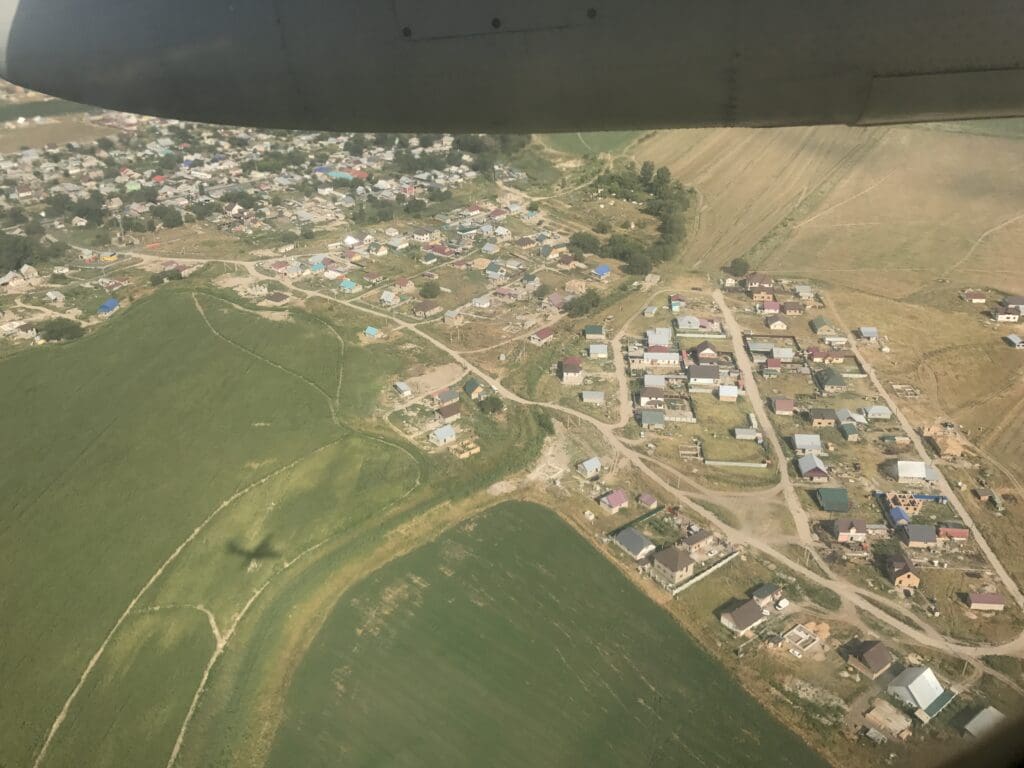
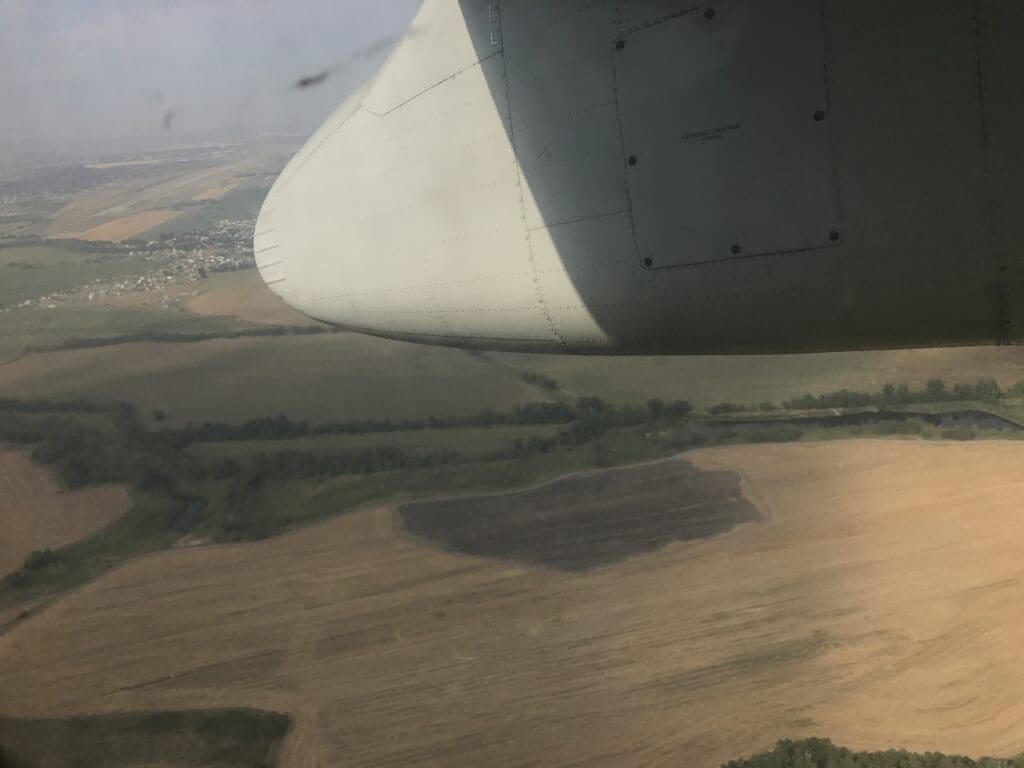
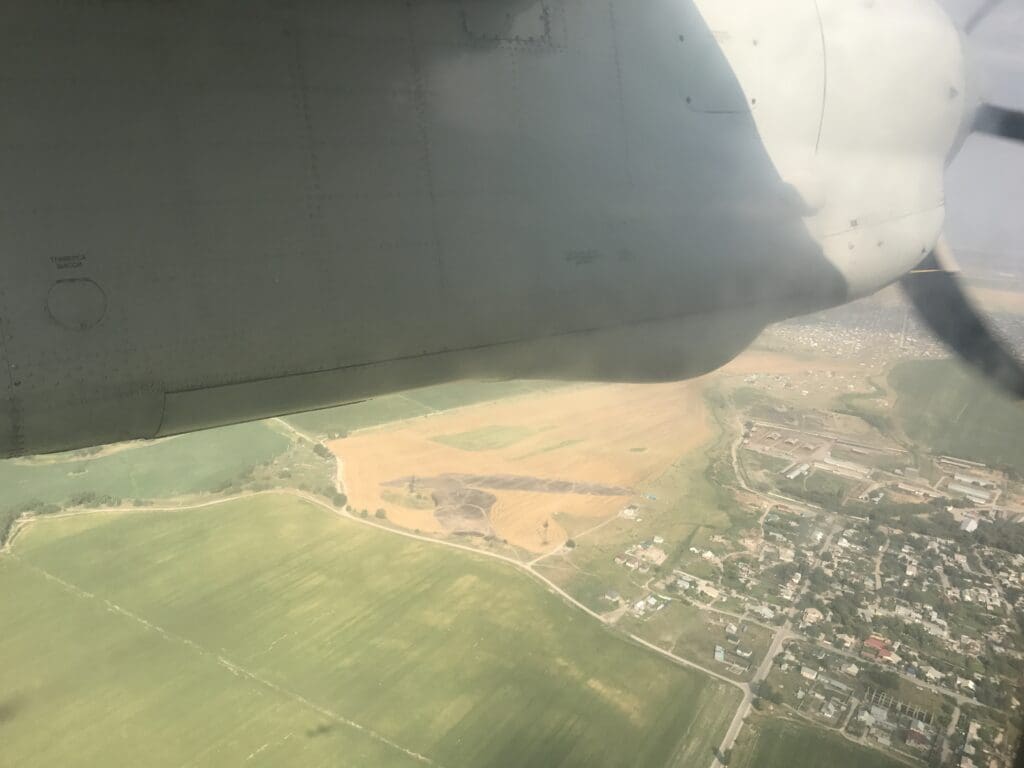
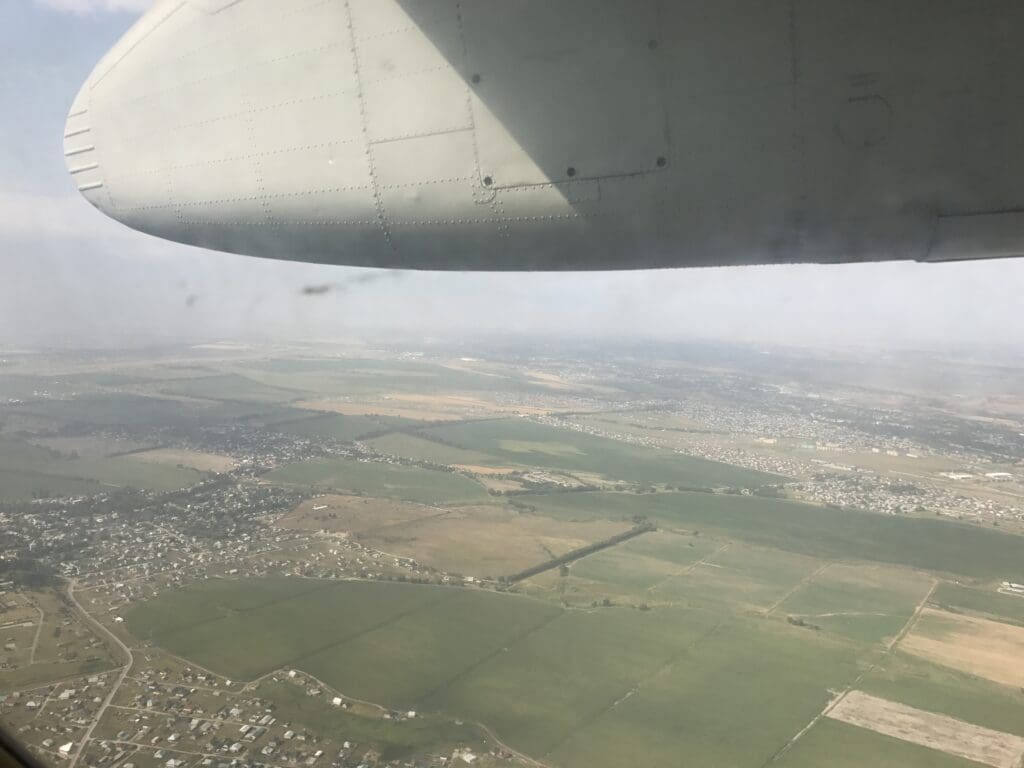
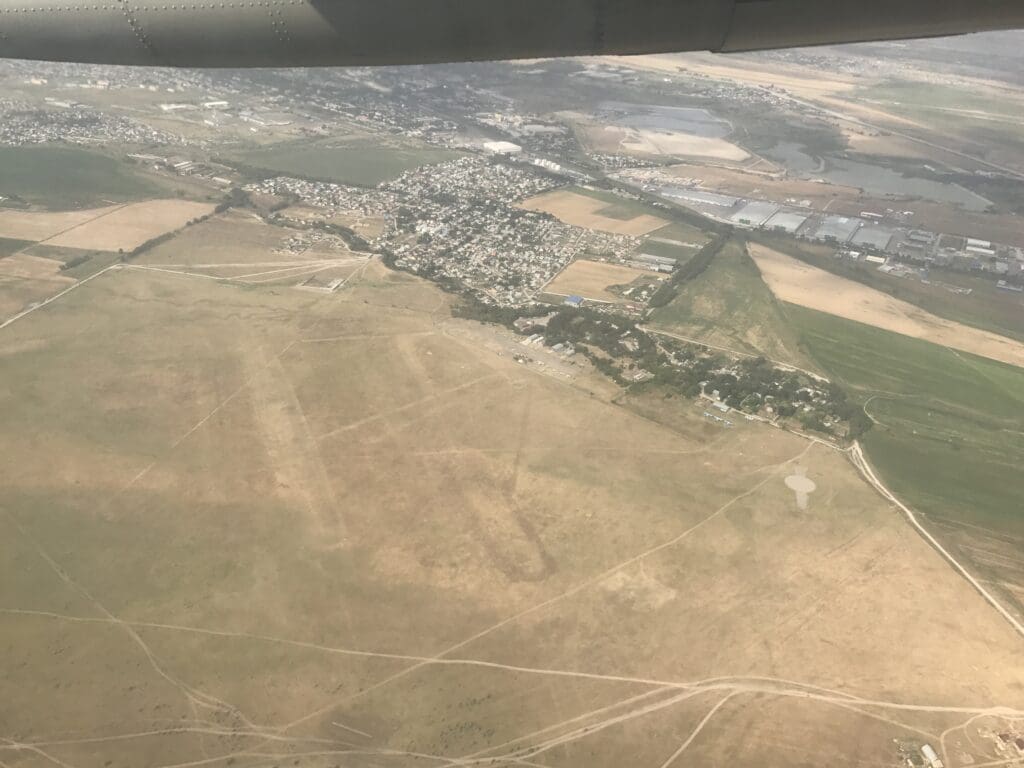
Upon reaching our cruising altitude, the noise in the cabin remained at a loud growl and the intense vibrations continued causing the mirrored ceiling to emit a slightly annoying rattle for the duration of the flight. Precisely fifteen minutes after our aircraft had taken to the skies, the steward walked towards the front of the aircraft and into the cockpit with a full tray of food, before emerging again and making their way back to the rear galley. A few minutes later, they emerged carrying a tray of cups filled with cola, fizzy lemonade and orange juice, although unfortunately for him, at this time, the aircraft seemed to hit a patch of light turbulence. Whilst the tray of food that had been delivered to the cockpit had gotten my hopes up that we were to be treated to some sort of breakfast service, in reality the service was to consist of nothing more than a round of drinks. Whilst this was no major issue given the length of the flight and the fact that I was purely onboard due to the unusual aircraft type operating the service, this is a slight mismatch with the service onboard SCAT Airlines’ own flights where passengers are offered a light snack at the very least. Anyways, once the flight attendant reached my row, I picked a SCAT Airlines branded paper cup at random and found this to contain lemonade.
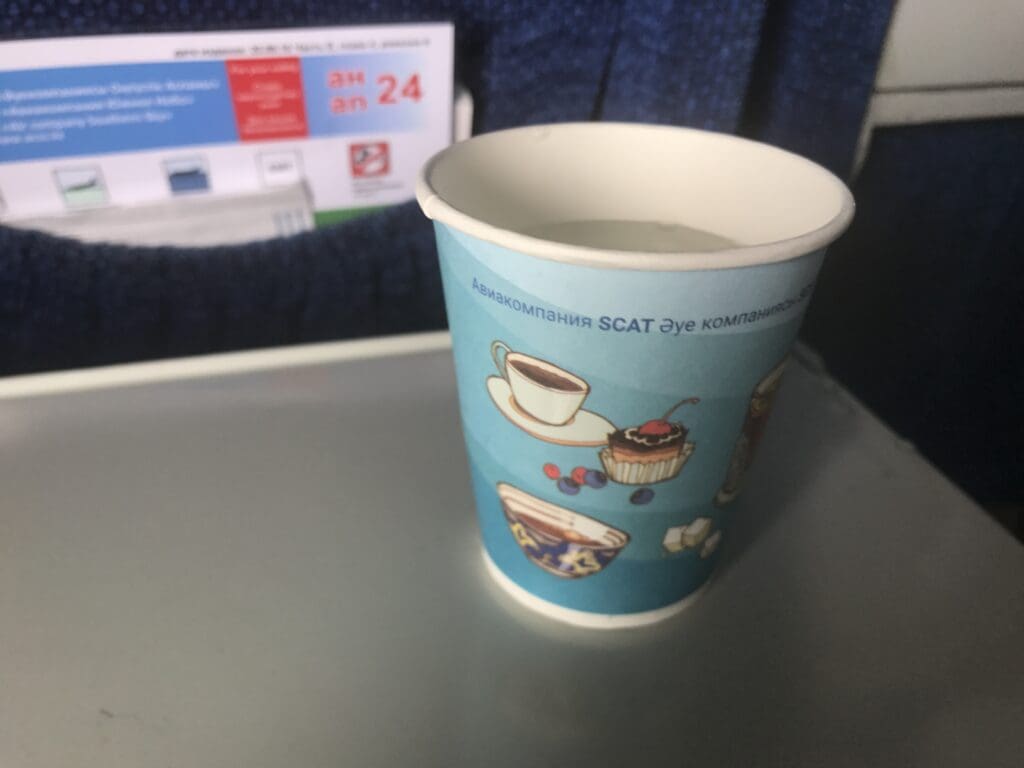
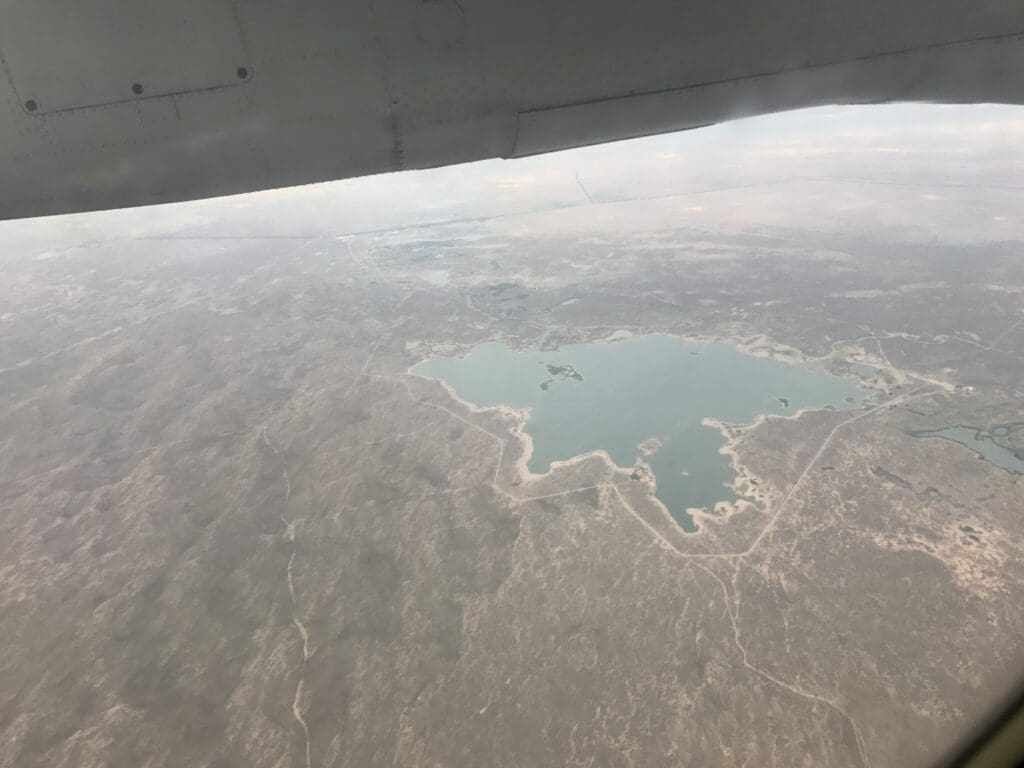
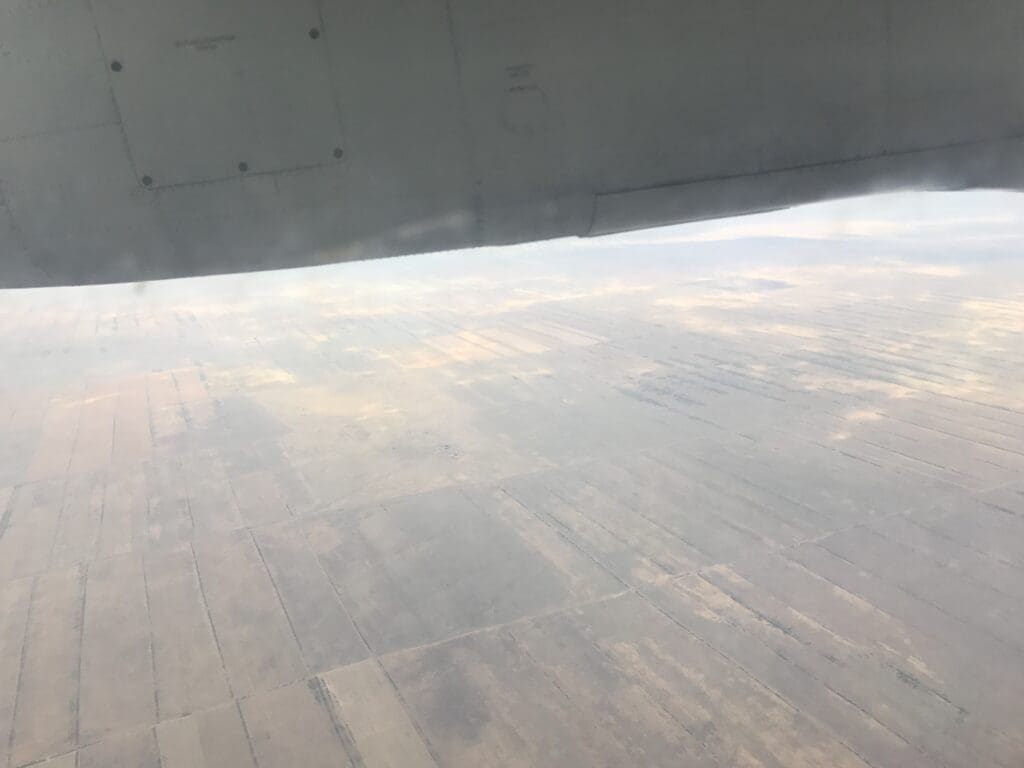
Ten minutes after the drinks service had been concluded, the roar from the two Ivchenko engines decreased slightly and the aircraft’s nose pitched down indicating the commencement of our descent. This was then immediately followed by the second announcement of the flight, presumably announcing that the aircraft had begun its descent and providing all the usual pre-arrival warnings. After this, the flight attendant passed through the cabin ensuring all seatbelts were fastened before coming for a final time with boiled sweets. Turning my attention to the outside world, a short while after starting our descent, our aircraft broke through the thin layer of cloud that had served to prevent any views of the land below for much of the flight. Beneath us a bright and sandy yet seemingly remote landscape could be seen, with this becoming darker as we approached the southern shores of the turquoise-coloured Lake Balkhash. This lake is the fifteenth largest in the world, comparable in area to Kuwait and is notable for the fact that half of the lake contains fresh water whilst the other half contains salt water. Crossing at a fairly narrow point, our transit over the lake only took around six minutes during which time we were thrown about thanks to a reasonably bumpy patch of turbulence which resulted in my tray table extending multiple times.
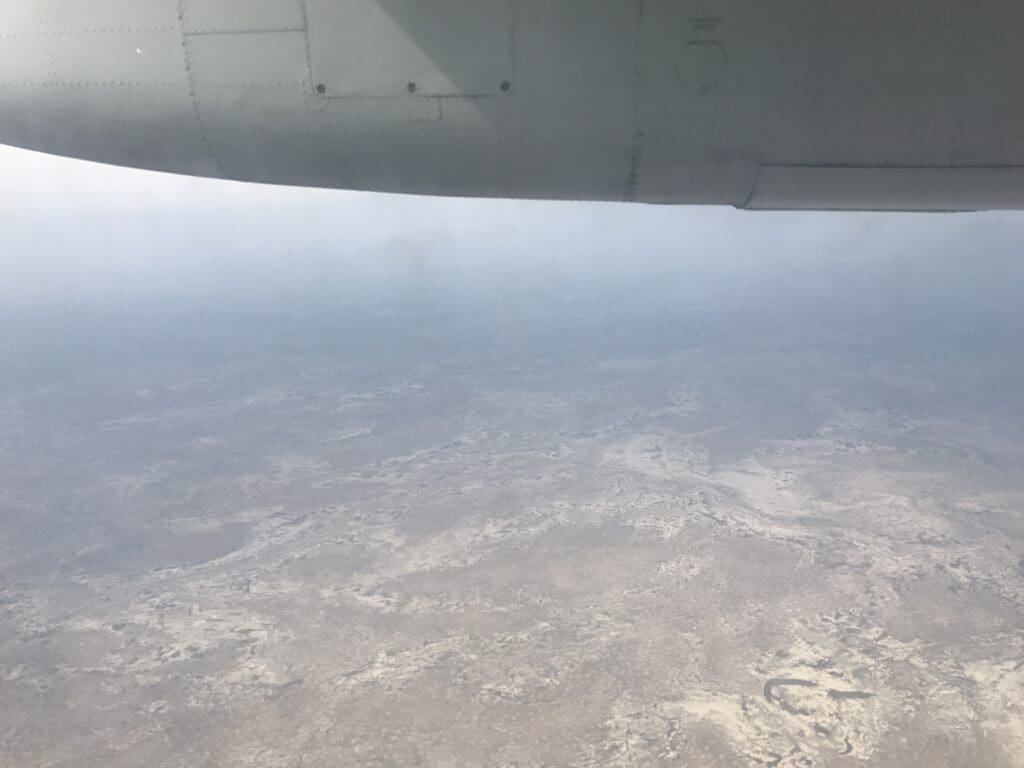
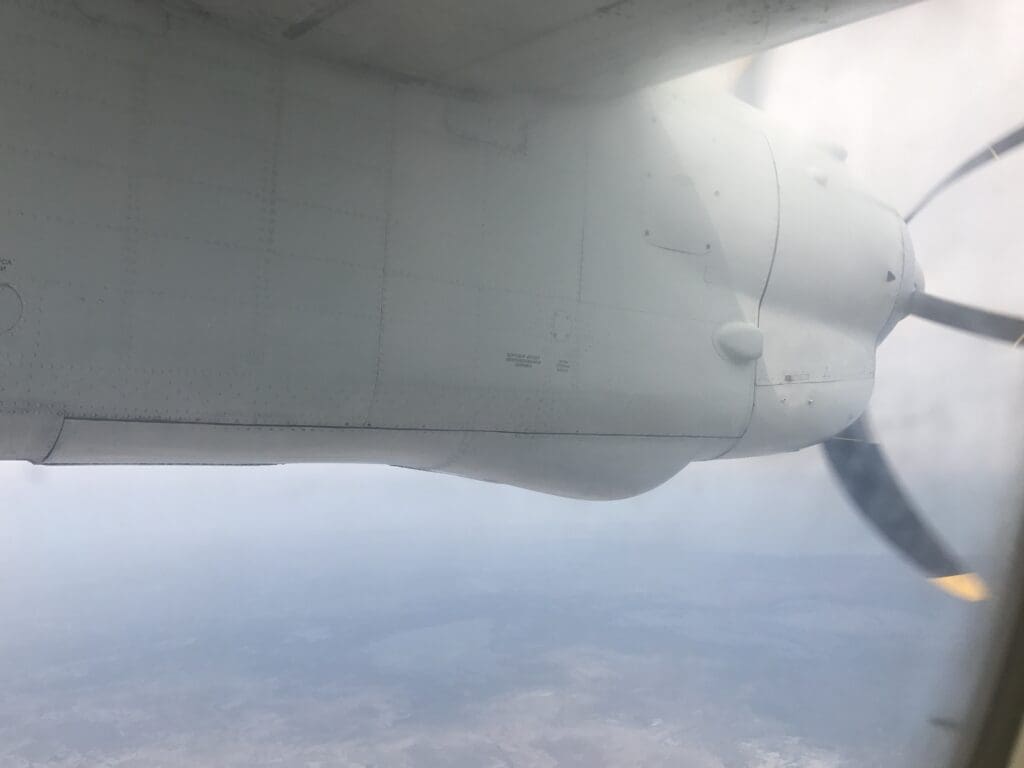
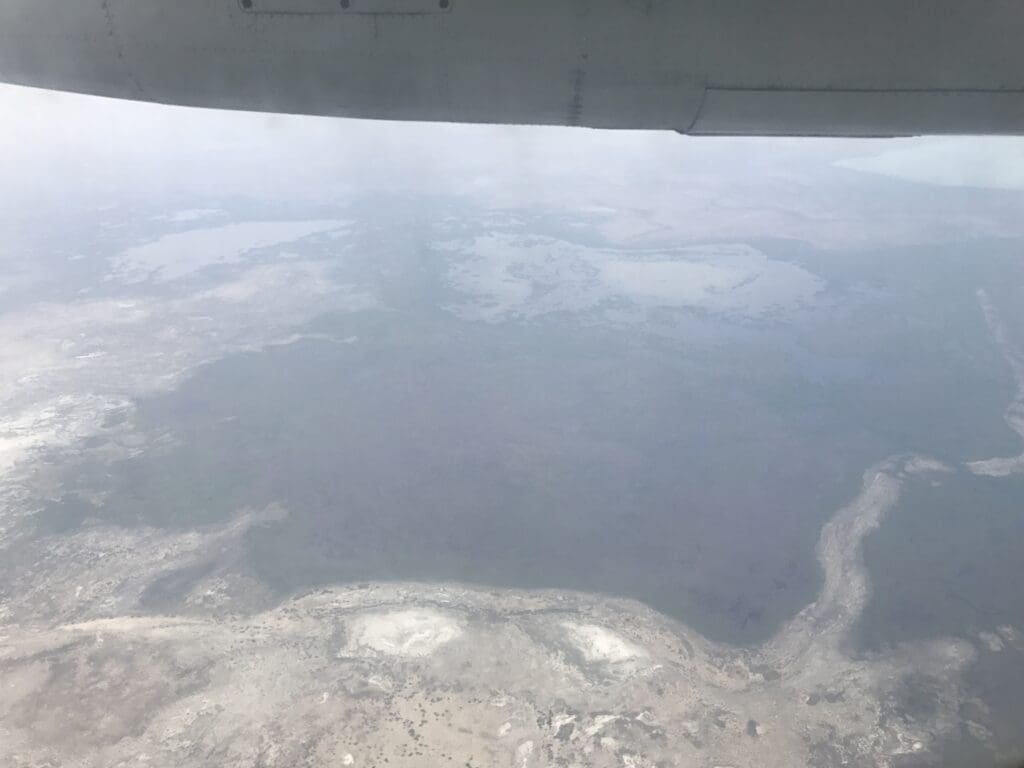
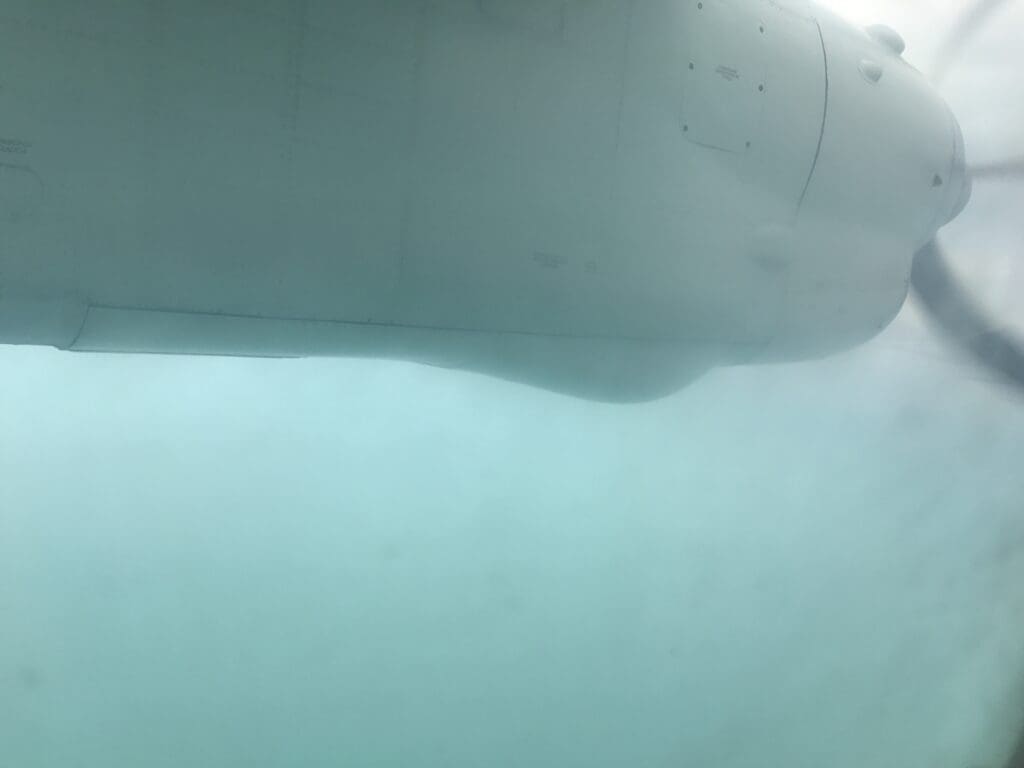
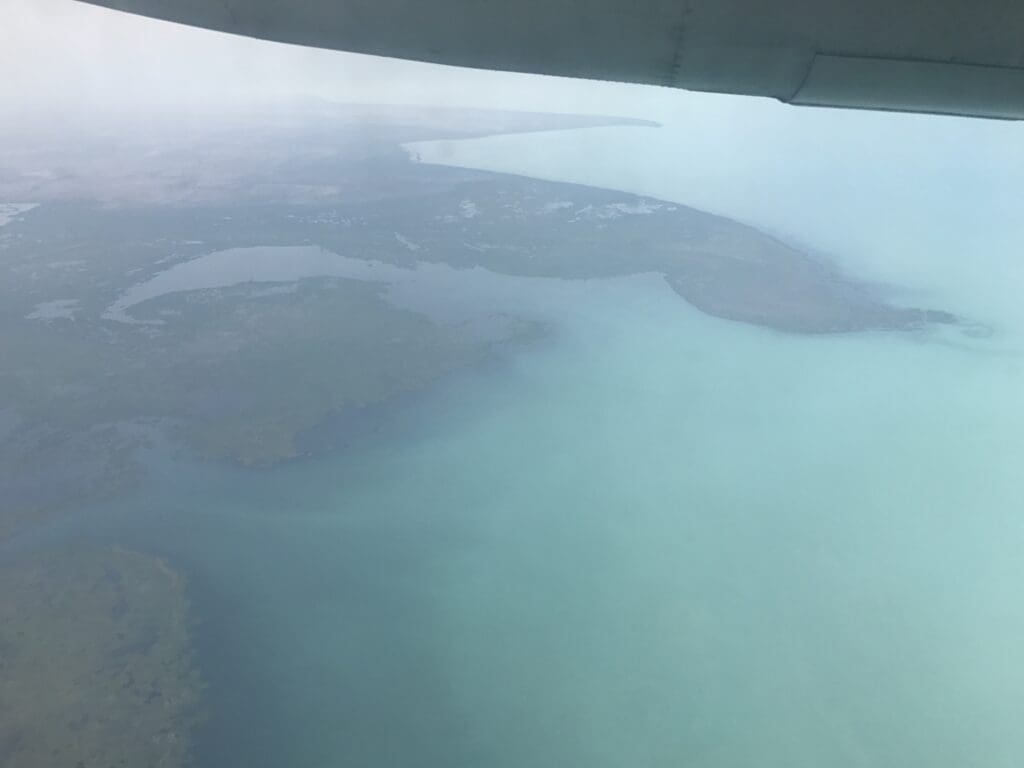
By the time our aircraft reached the lake’s northern shores, our low altitude allowed for a good view of Balkhash City, home to around seventy thousand people thereby making it the 24th most popular city in Kazakhstan. As we neared the airport, grey skies above and fact that the cabin lighting remained off for the entire flight ensured that the interior remained somewhat dark and dingy. Once we had passed over the city, the Antonov made banked gently allowing for good views of the deserted landscape below, with only the occasional dirt road and pack of horses seen as we descended.
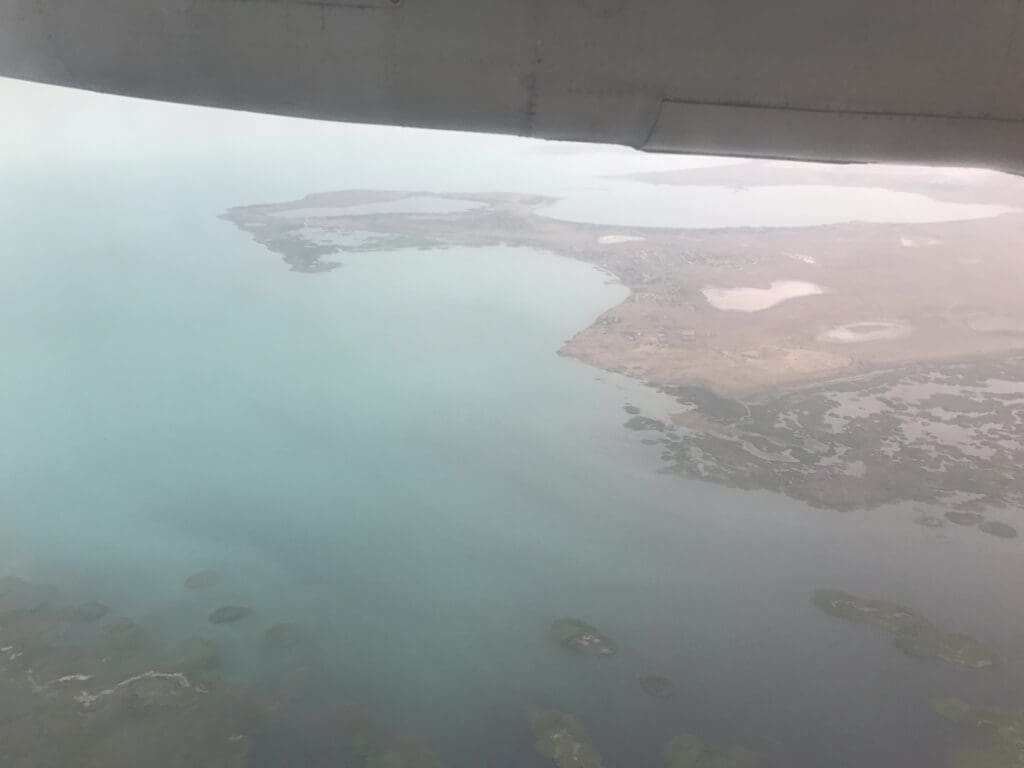
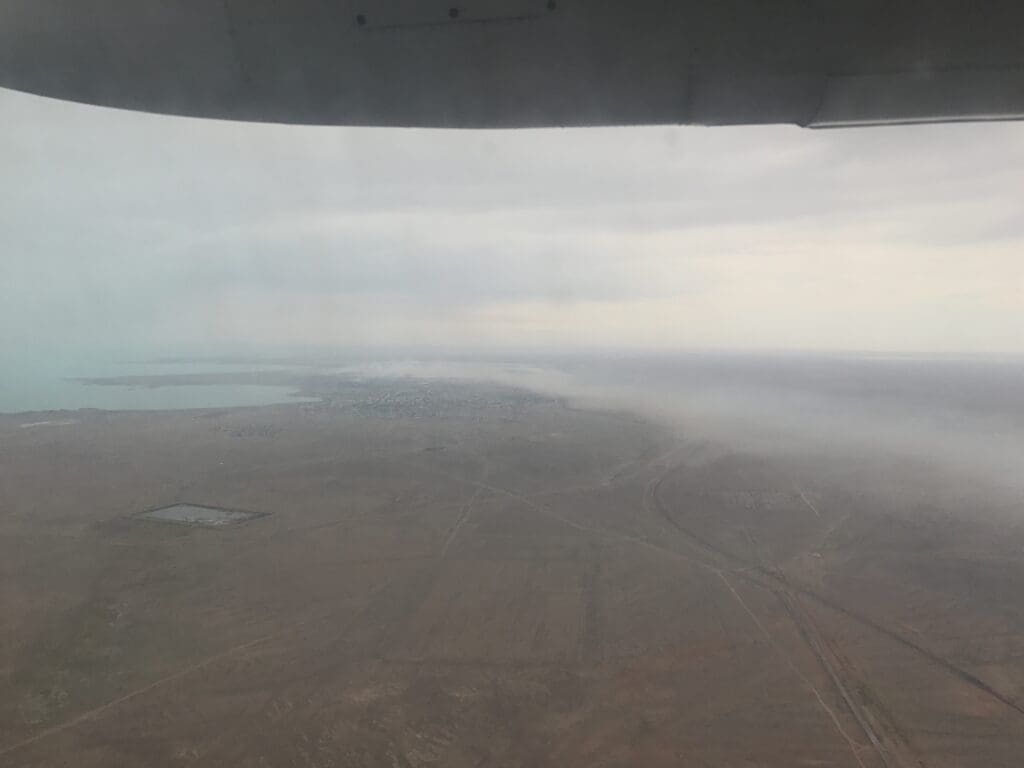
At 1018 the landing gear fell down into position almost instantly and we made our final bank that would line us up for an approach to Balkhash’s Runway 23. Once the flaps were lowered, the aircraft commenced a relatively steep dive down to the runway before pulling up and floating for a while before making a barely noticeable touchdown on the runway’s concrete surface. After touching down the noisy reverse thrust then roared into life whilst minimal braking was applied – this was somewhat unsurprising given the 2500-metre feet long runway. As the aircraft decelerated, the bunkers of Balkhash’s military airfield popped into view before the Antonov finally vacated the runway and made a short taxi towards the passenger apron.
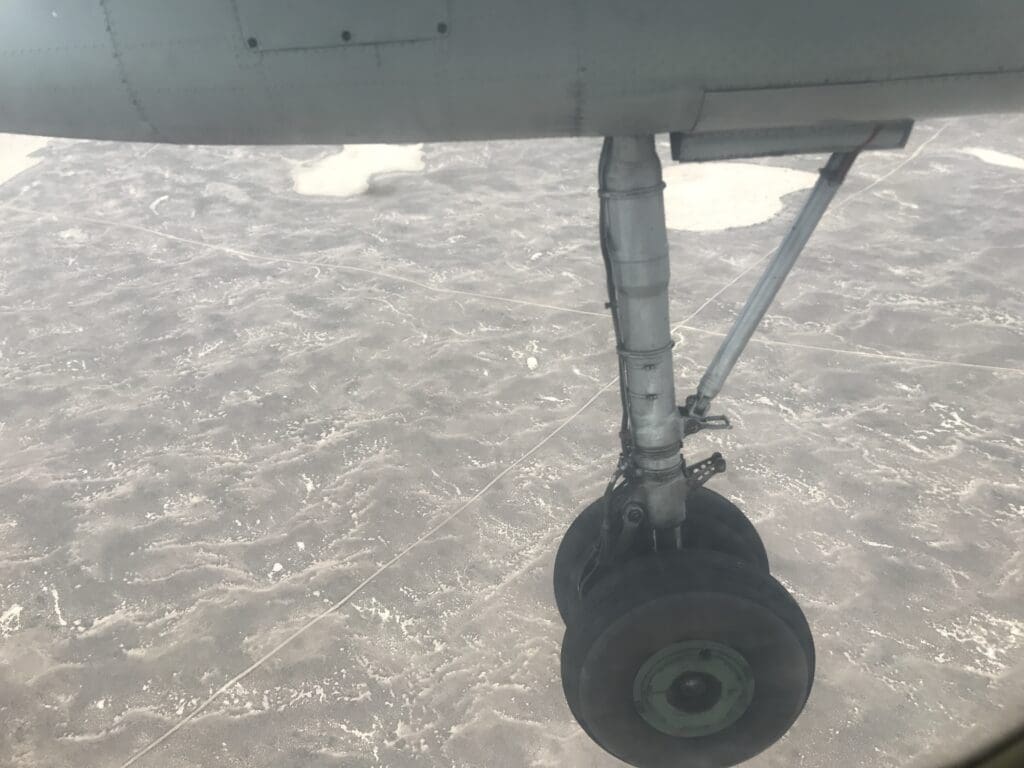
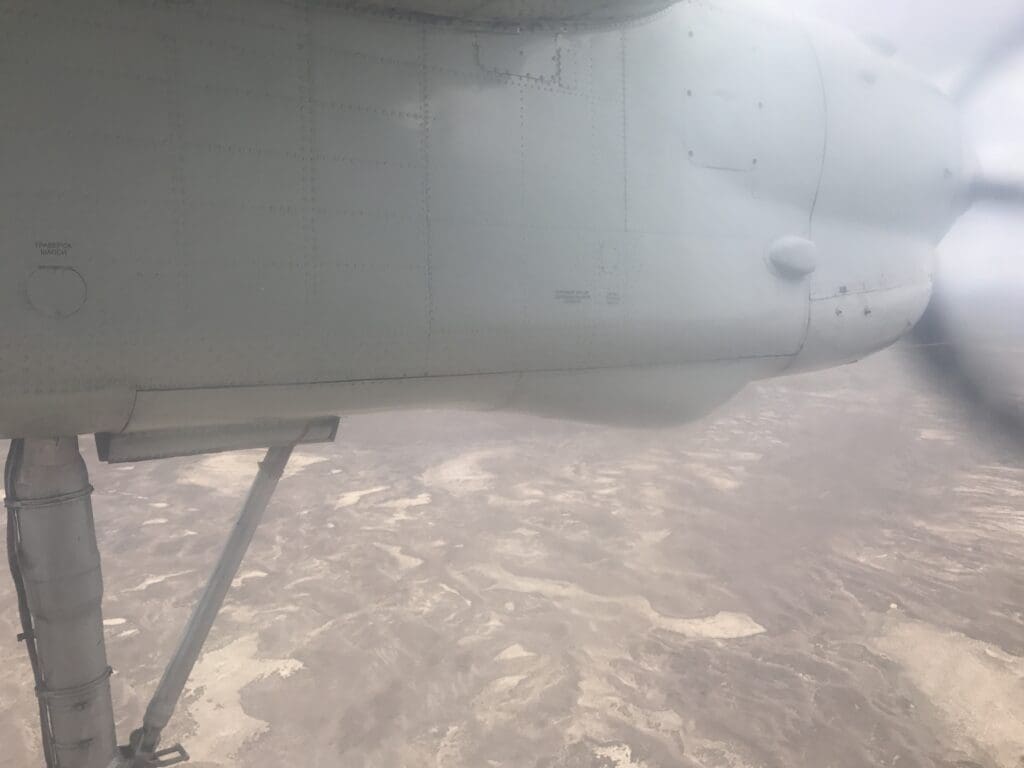
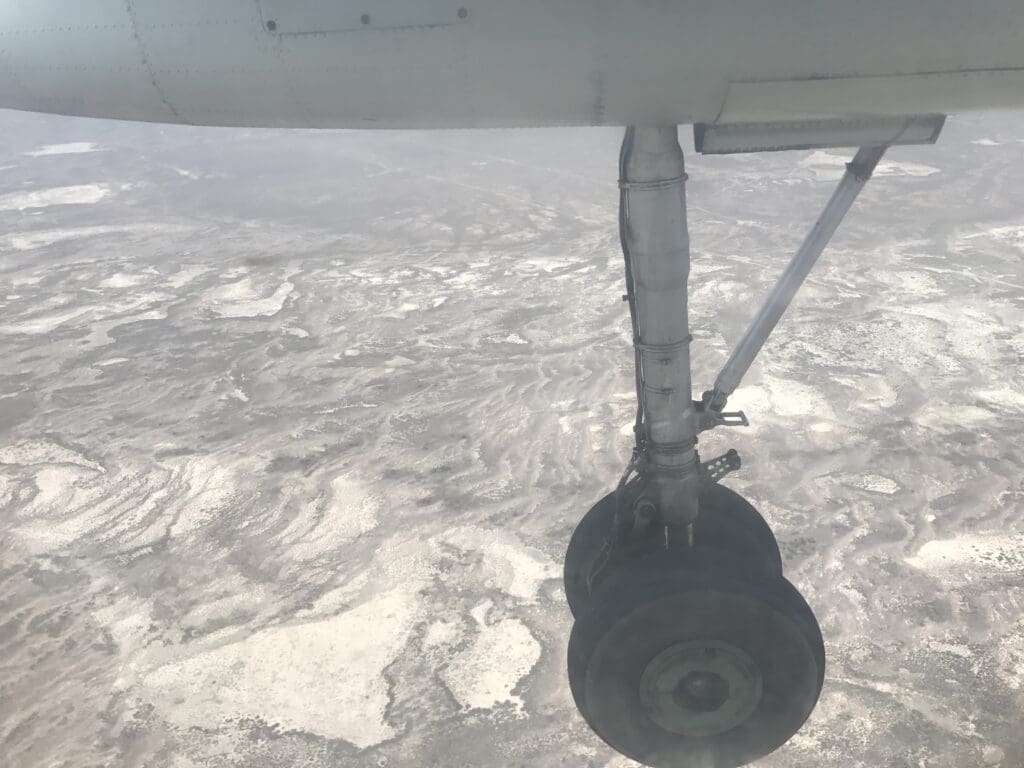
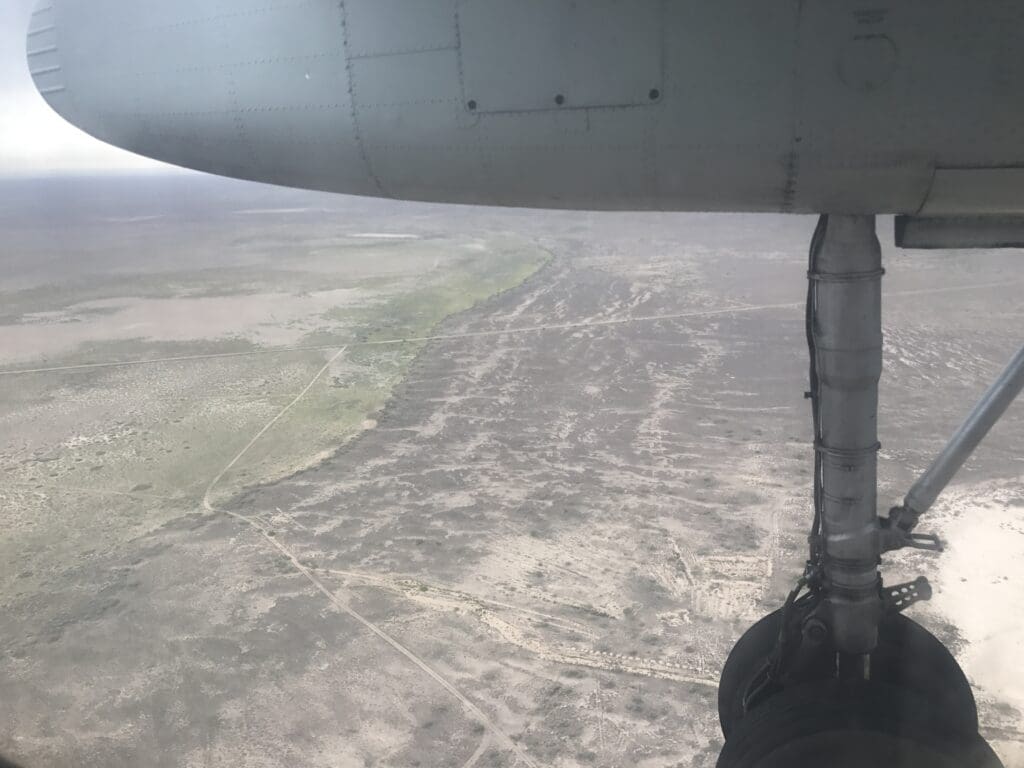
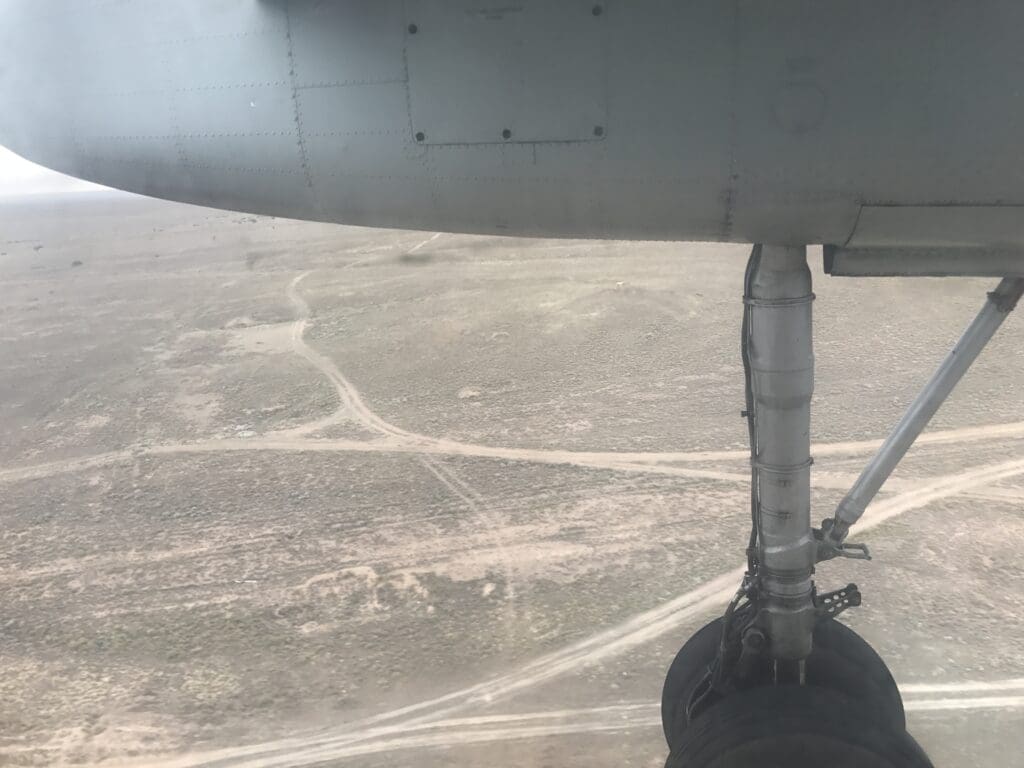
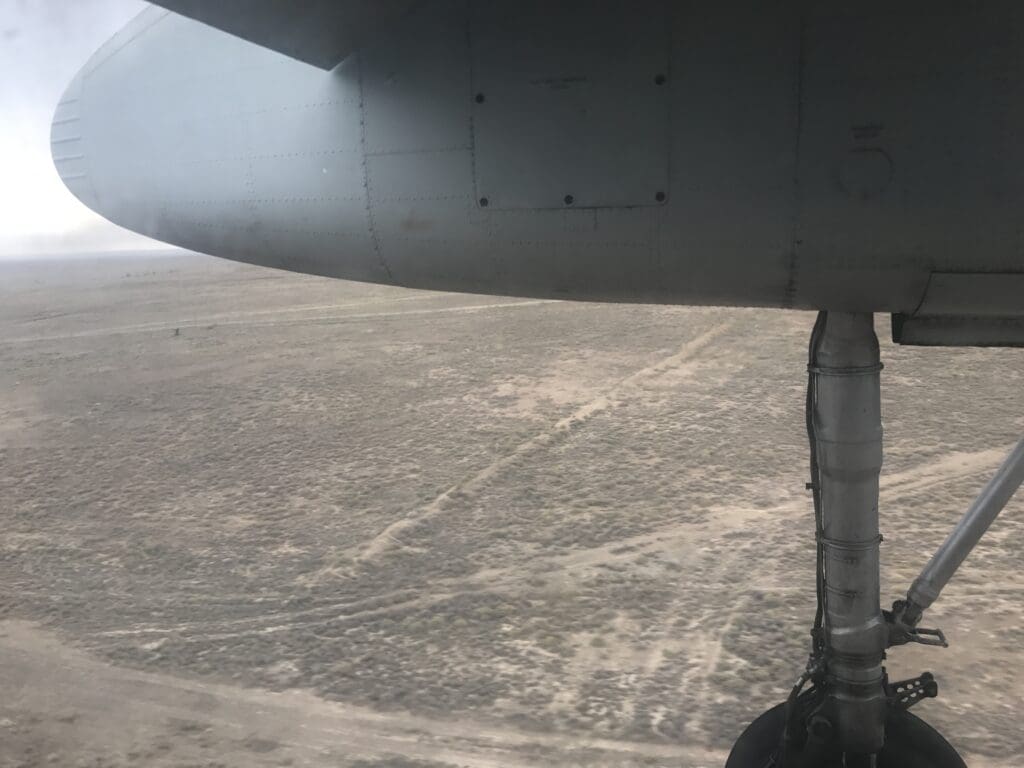
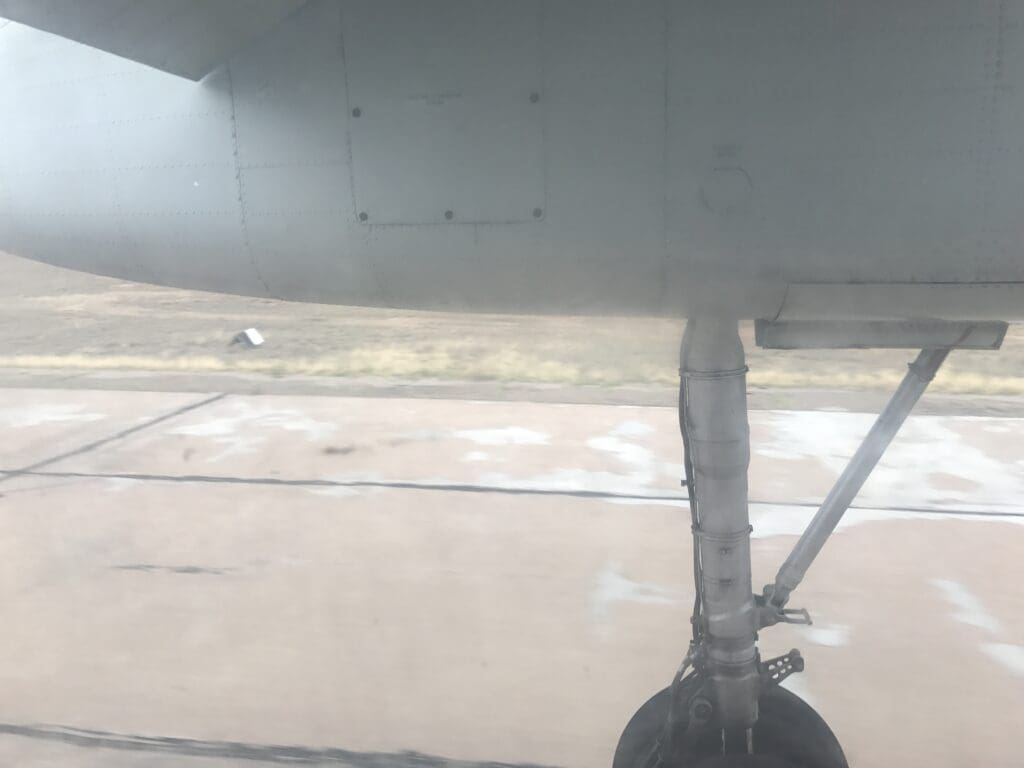
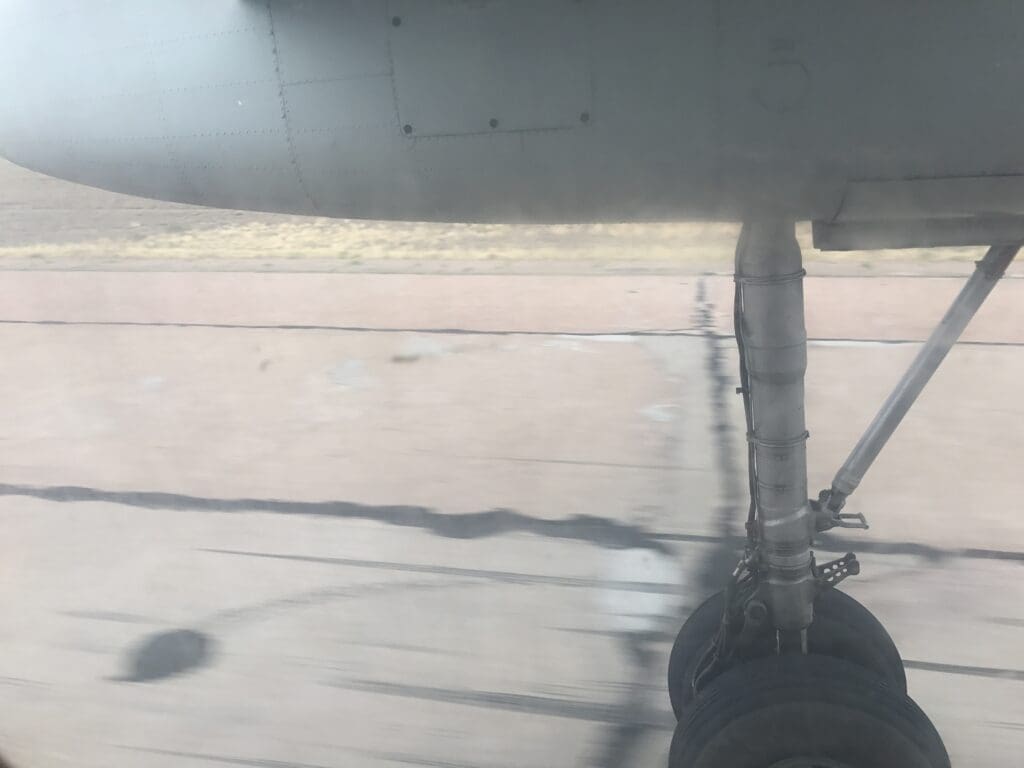
Within a few minutes, the Antonov came to a halt next to the small yet grandiose terminal building, pulling up near an Antonov An-2 and a Cessna 208. Soon, the two engines spooled down and the cabin fell silent. Unlike on many flights whereby passengers race to the door as soon as the aircraft comes to a halt, the passengers onboard this flight appeared to be in no hurry to leave the Antonov. After a couple of minutes, the main cabin door was opened after which passengers began to disembark.
After being thanked by the flight attendant, I carefully climbed down the steps and onto the apron, marking my safe return to dry land. Looking up, I spent a few moments admiring the terminal building, this featured ornate motifs and a small clock, with this topped by a small tower. Built in the late 1940s by Japanese soldiers captured by Soviet forces in Manchuria and Korea during the final stages of the Second World War, today this building serves little purpose to passengers bar being home to the toilet facilities, with arriving luggage collected at the aircraft and the departures area replaced by a small single story structure. As I crossed the apron I noticed the happy airport puppy yapping away whilst being petted by a member of the ramp workers.
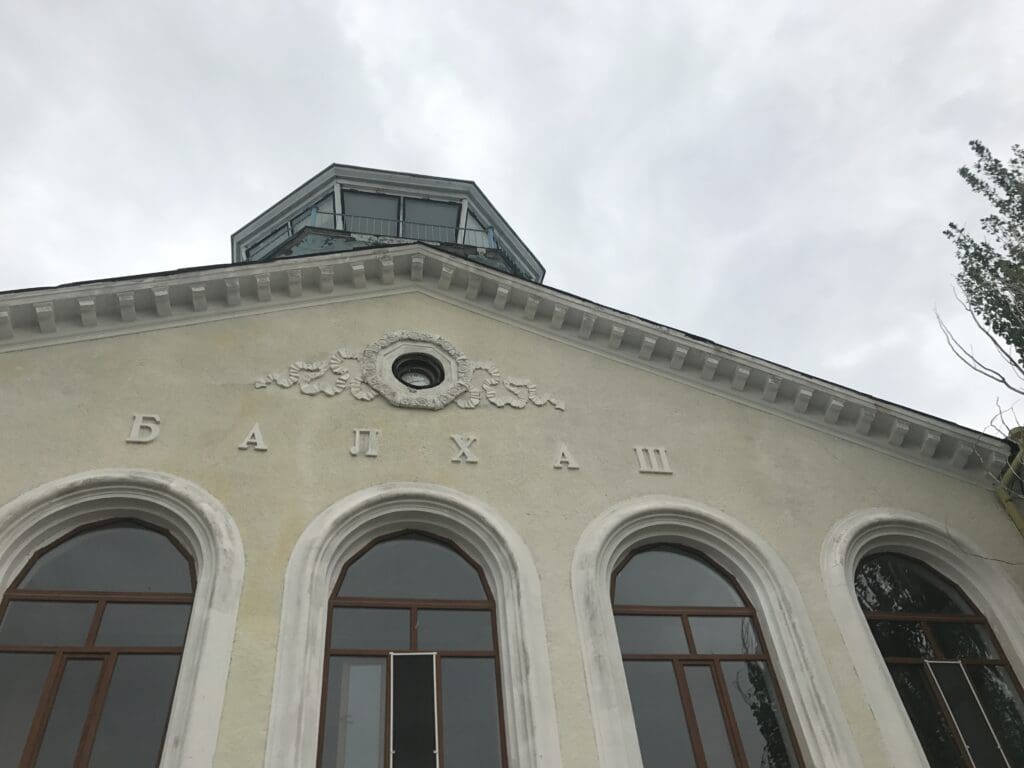
After a quick toilet stop, I entered the bungalow terminal and found myself standing in a room that bore a far greater resemblance to the ticket office of a small station than to the check-in area of an airport. After waiting at the single counter for the person in front of me to pay for their ticket (hoping that my seat had not just been sold), I slipped my reservation and passport through the gap in the window and through the magic of Google Translate I was asked whether I had any baggage. After giving a negative response to this question, the sole remaining seat (an aisle seat – 10C to be specific) was crossed off a paper copy of the seat map of the Antonov before the check-in agent filled out my first ever handwritten boarding pass.
After receiving my boarding pass I passed through to the security area which was manned by a single airport employee donned in a reflective jacket. Here both hand and hold luggage were sent through a topless X-ray machine, allowing passengers to see their bags as they passed through before hold luggage was separated and carefully carried out to the aircraft one by one. From the security checkpoint I headed into the busy waiting area where it was standing room only. This consisted of a large square room with benches along the sides, plain white walls and a top-down diagram of a Tupolev Tu-154 on the floor. Inside, there was a rather light hearted atmosphere, with most passengers consisting of families heading up to the capital. Whilst the Antonov An-24 may not be the quickest airliner in the world, compared to the weekly train service between Balkhash and Astana, the Antonov was far quicker, with the train taking over 11 hours to make this trip.
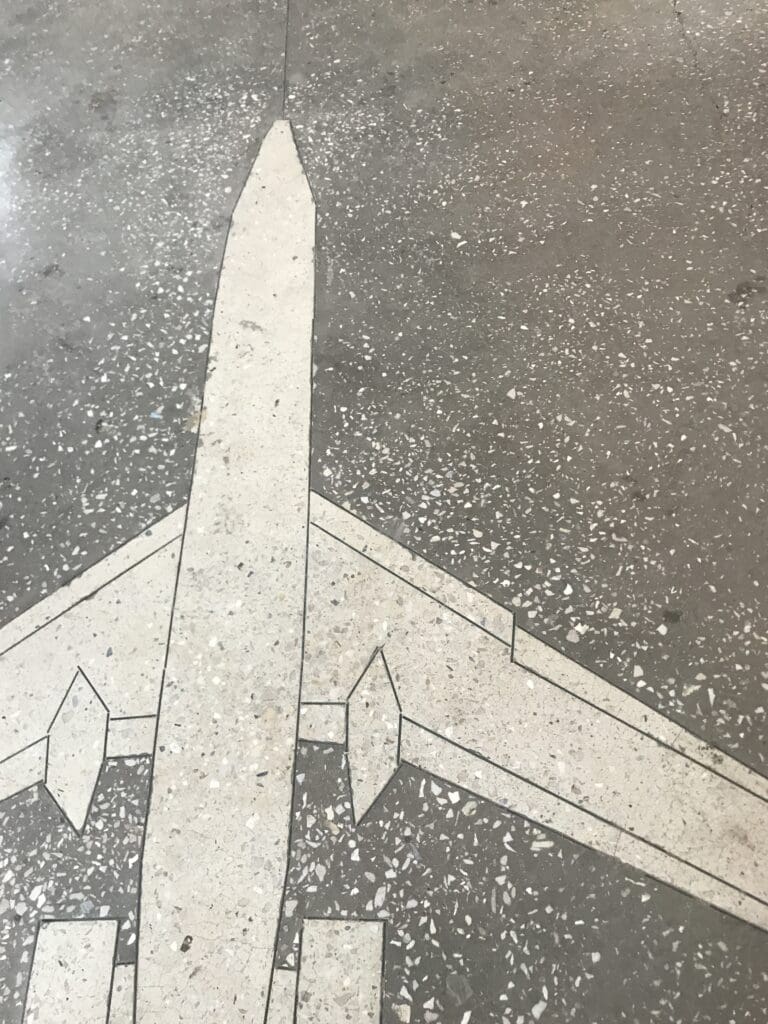
Outside, the cockpit crew could be seen taking a breather before the longer sector up to Astana. Then, suddenly at 1100, without any sort of warning the door to the apron opened and passengers began to stream out of the building, heading across the apron to the aircraft, the airport puppy attracting a lot of attention from passengers both young and old as they made their way out to the aircraft. Once onboard, I was welcomed once again by the steward who looked a little surprised to see me again. Looking forward, the black panelled cockpit of the Antonov could be seen at the front of the aircraft, this remaining open until the crew returned onboard. Aside from being an aisle seat, my seat for this flight was identical to that I had sat in on the previous sector, with plenty of wear and tear but seeming to be in a reasonable condition aside from this.
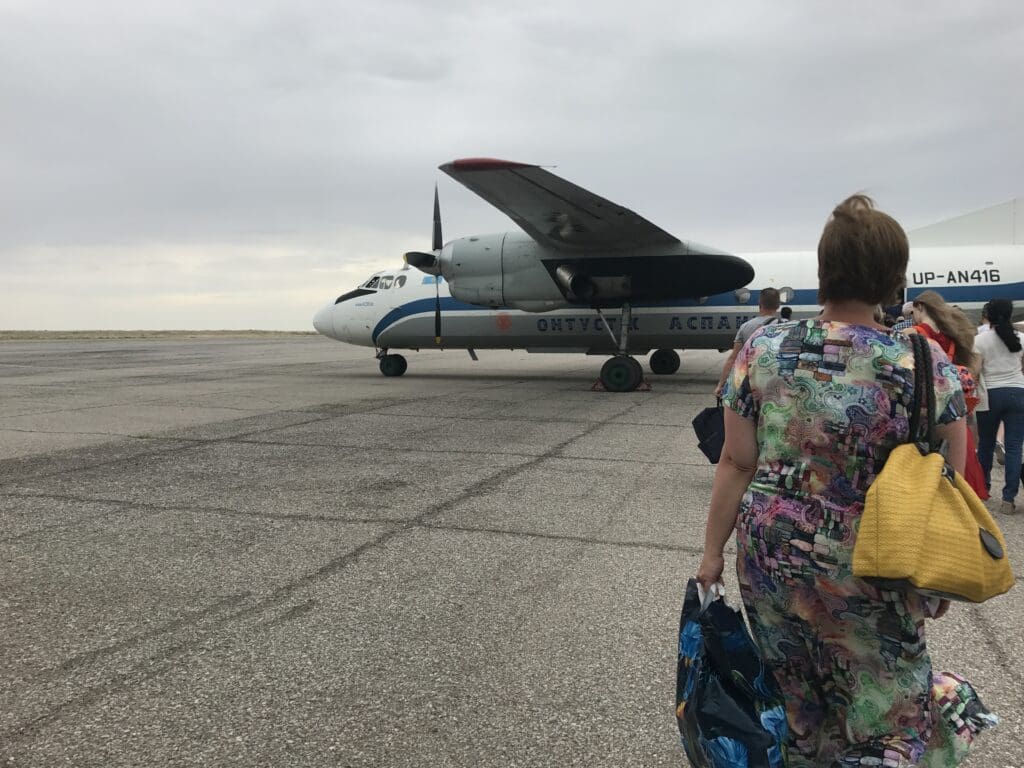
After a while, the cockpit crew rejoined the aircraft with the First Officer closing the cabin door whilst the flight attendant was midway through their welcome speech which was once again performed in Kazakh and Russian. At 1110 the cabin was filled with noise and I turned right to see the sight of flames spluttering out of our right engine as it began to spool up. You don’t get that on an ATR! Meanwhile, inside, the cabin was incredibly warm, with many passengers using the safety cards as DIY fans. After a few minutes, at 1113 our aircraft left the stand under its own steam and began a five minute taxi to the end of runway 23. From here, our aircraft once again performed a powerful yet long takeoff roll before heading up into the cloudy skies. As our aircraft ascended, my seatmate proceeded to talk loudly on his phone for around ten minutes as we rose up above rural Kazakhstan, thereby proving the impressive coverage of Kazakh phone networks (I’m often unable to get good reception at my parent’s house in a suburban area of the UK).
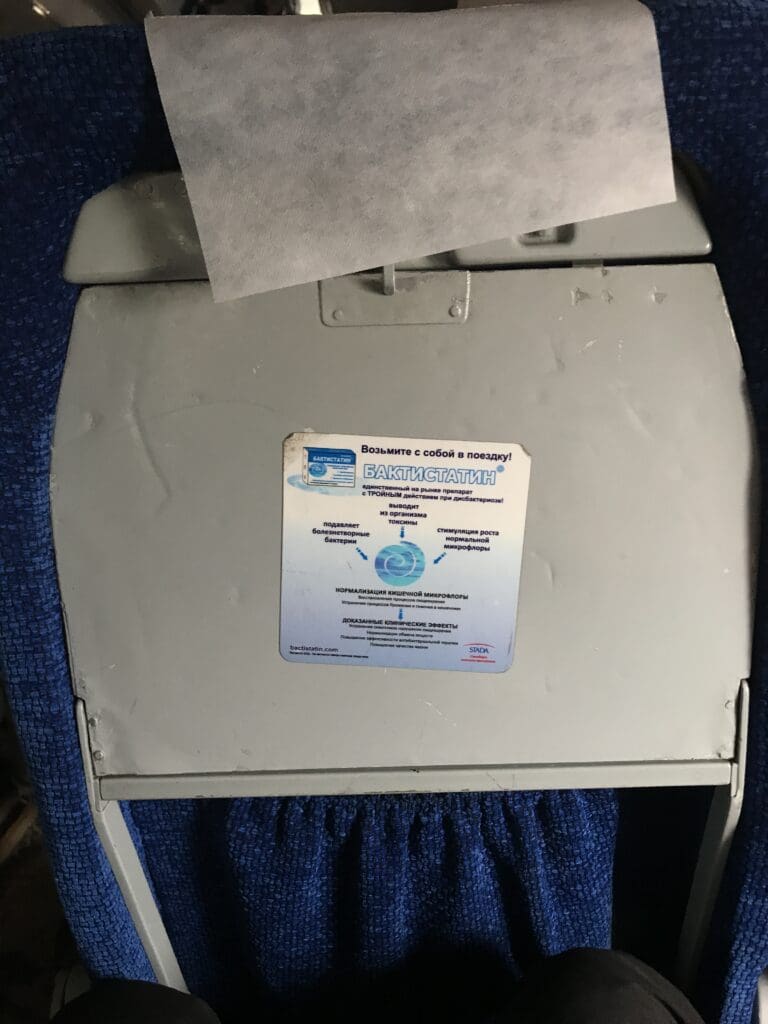
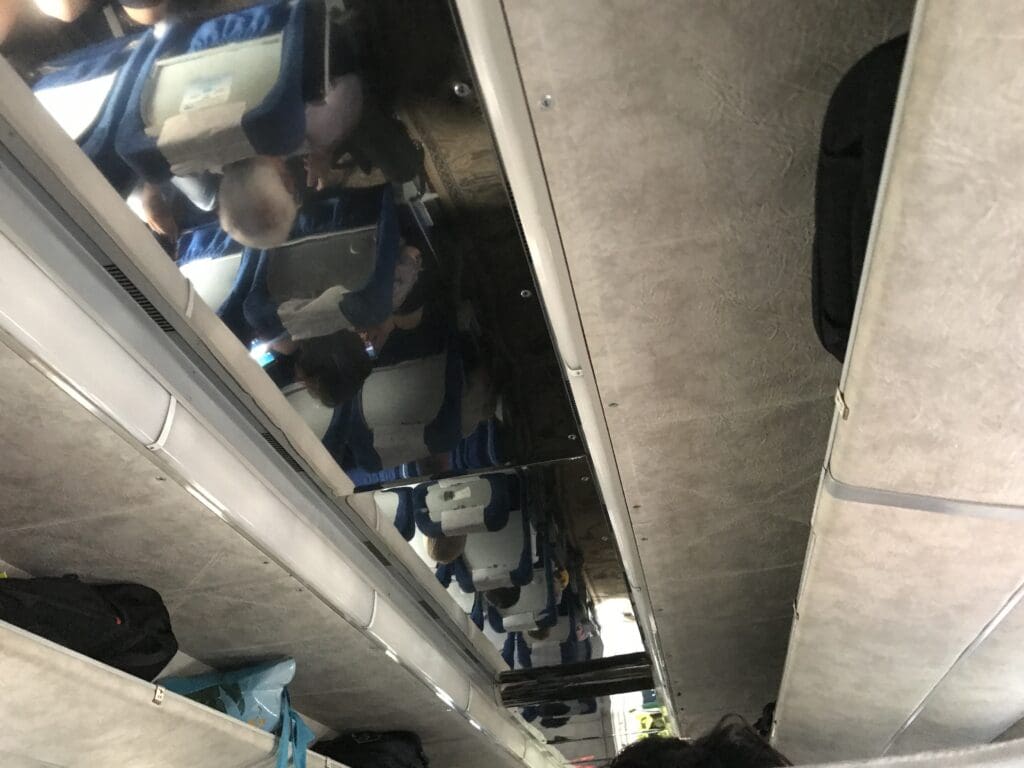
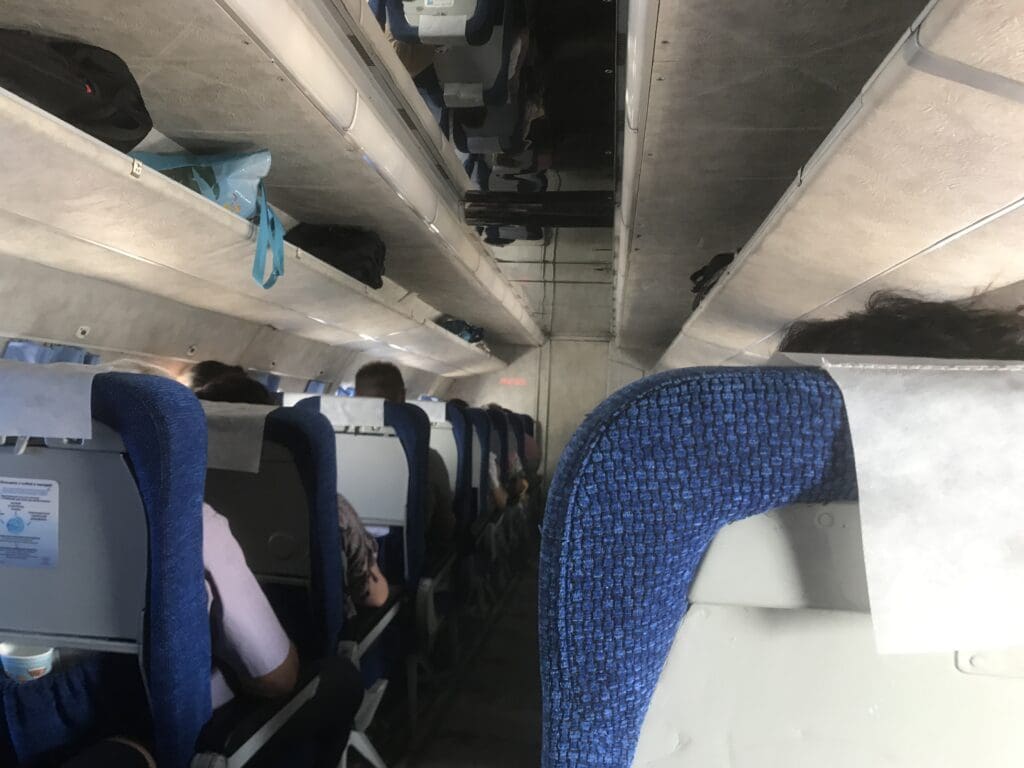
After levelling off, it was time for the cockpit crews’ second meal of the morning, with the flight attendant once again passing through the cabin with a tray full of food. Seeing as the leg from Balkhash to Astana was the longer of the two flights that morning, comparable in distance to the journey from London to Edinburgh or Seoul to Fukuoka, I was sort of hoping for at least a snack service to be made on this flight. However, I was out of luck, with the service on this flight consisting solely of a round of drinks. Once again, I picked a cup at random, and, by coincidence this turned out to be a cup of lemonade.
Seeing as I was sitting in an aisle seat, unfortunately I do not have many photos to share from this sector nor do I have a great deal to write about from this leg. During the flight, most passengers fell asleep or occupied themselves with books, tablets and phones as we sped northwards towards the capital. Around an hour and fifteen minutes into the flight, our aircraft could be felt sinking back down to earth, glancing to my right, I could see the sandy coloured landscape transforming into a greener colour as we continued heading downwards. After a few gentle turns, at 1241 our aircraft made another smooth touchdown which was followed by a welcome announcement in Kazakh and Russian. Through the porthole, I caught a glimpse of Astana’s shiny and seemingly modern terminal as we made our way to the apron, this serving to be in stark contrast to the small, single story shed-like terminal we had left behind in Balkhash. Within a couple of minutes, the engines shut down and the patient passengers remained seated before several knocks could be heard at the rear of the cabin which was followed by the opening of the cabin door.
This time, the aircraft’s metal ladder was not used for disembarkation and instead some shallower steps had been pushed up to the aircraft. Once I had thanked the flight attendant, I headed down the steps and onto the awaiting bus. Despite the full load of passengers, disembarkation was over quickly and soon enough the bus doors were closed and we were slowly transported towards the main terminal bringing my Antonov 24 experience to a close. Whilst my journey from Almaty to Astana was neither the cheapest nor most direct option, for an aviation enthusiast it was undoubtedly the most interesting routing and I am very pleased I managed to catch a couple of flights on the relatively rare Antonov 24 for a more than reasonable price. As it would happen, a couple of years later I would find myself rumbling through the skies of Ukraine onboard a Antonov An-24, operated by the well known carrier (at least by aviation enthusiasts) Motor Sich Airlines.
